Vogue Travel
Get Travel Ideas and Inspiration with Vogue Travel

Search This Blog
9 places to go sand yachting in normandy, during your next vacation, practice sand yachting in normandy here are 9 beaches for sand yachting in normandy.
With sandy beaches as far as the eye can see, Normandy is the ideal region for sand yachting. The so-called “ship of the sands” was already used several millennia ago by the Egyptians! It was Europeans who made it a hobby more than a century ago. Between the wheeled car and the small sailboat, sand yachting in Normandy is an activity that quickly offers feelings of freedom and fun. At ground level, you use the force and direction of the wind to gain speed and move. This very accessible water sport does not require any particular physical condition.
1. Landing Beaches

Crédit Photo : Shutterstock – photoneye
Sword Beach, Juno Beach, Gold Beach, Omaha Beach, Utah Beach ... Welcome to the Landing beaches, rich in history and emotion! Here, you can combine the practice of sand yachting and visiting the museums dedicated to this military operation of the Second World War .
Also Read: 18 Most Beautiful Beaches in Normandy
Located on a protected natural site, the kilometers of Omaha Beach and Utah Beach are ideal for nautical leisure. Arromanches-les-Bains is also one of the unmissable beaches for sand yachting in Normandy. Nicknamed Gold Beach, it still bears the traces of the large artificial port which welcomed the Allied troops during the liberation of 1944. Providers offer sessions of two to three hours throughout the year.
2. Saint-Aubin-sur-Mer

Credit photo: Shutterstock - Christian Musat
Located very close to Dieppe on the Côte d'Albâtre, the sandy beach of Saint-Aubin-sur-Mer provides easy access to sand yachting, especially when coming from the Paris region. Dieppe is indeed just over two hours from Paris . Saint-Aubin-sur-Mer is the most imposing beach in Seine-Maritime.
Just after the tide, the sea recedes, gradually creating a huge race track. All year round, depending on the tide times, two-hour sessions are offered by local clubs.
3. Consider the Sciotot
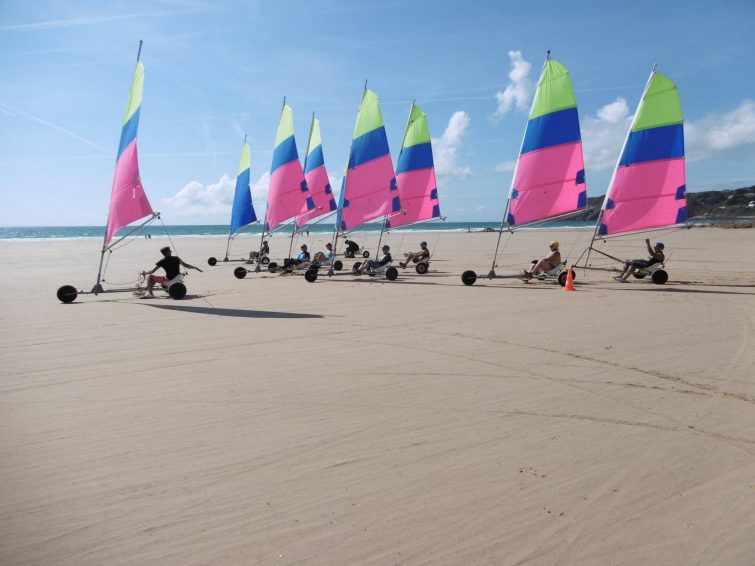
Photo Credit: Facebook - Sciotot Sailing and Wind Activity Center
Among the Cotentin beaches, that of Sciotot is a perfect spot for sand yachting in Normandy. Between the Flamanville and Rozel capes, it is part of the commune of Les Pieux in the Manche. Its stretch of sand is four kilometers long. Its wild aspect and its size make it an excellent playground for all, from the age of 8 years.
Did you know that in 2019, the newspaper Le Monde ranked Sciotot fifth most beautiful beach in Europe ? All the more reason to consider a nautical leisure stay!
4. Trouville-sur-Mer
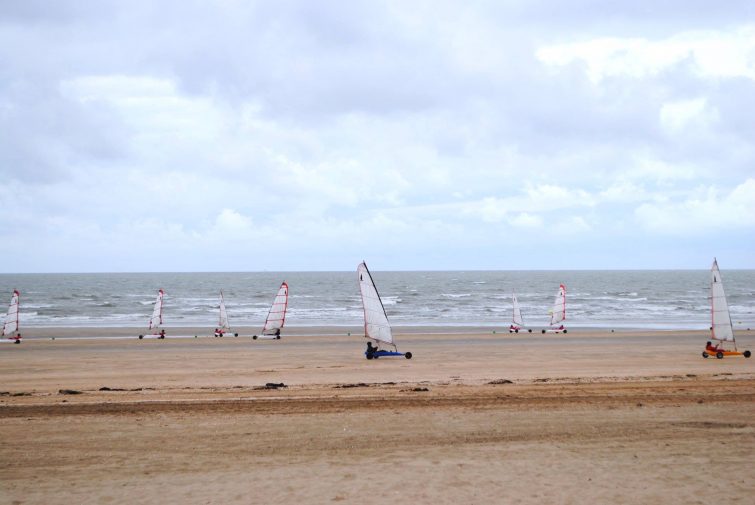
Photo credit: Facebook - Trouville sur Mer Tourist Office
To practice sand yachting in Normandy in a mythical place, you have to come to Trouville-sur-Mer. Located very close to Deauville, this seaside resort is the oldest in the region. Its large sandy beach stretches for 1.2 kilometers. It combines nautical leisure, relaxation and history.
In Trouville, you can not only try sand yachting, but also discover Beach Karts! These small remote-controlled vessels take up the codes of land yachting, on various routes. Finally, children's clubs and facilities allow the whole family to have fun at the same time.
5. Jullouville
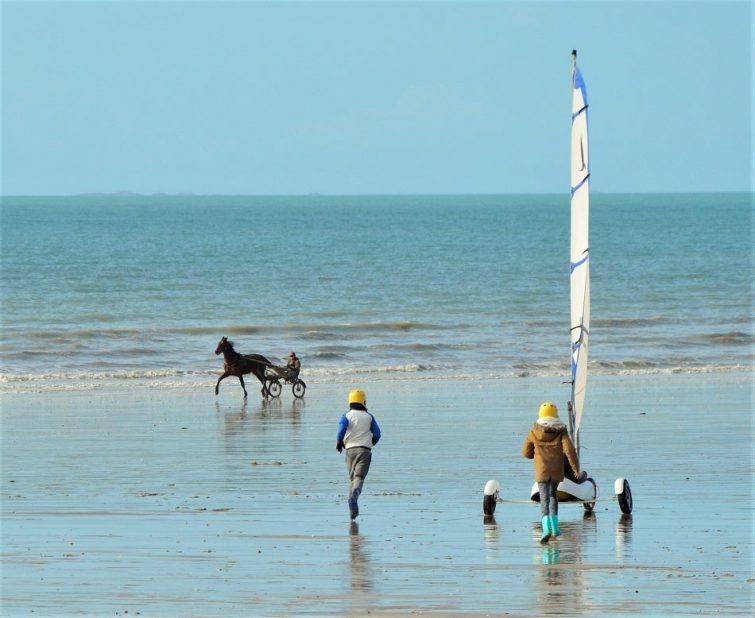
Photo credit: Facebook - Jullouville town hall
Located 8 kilometers from Granville, the large Jullouville beach stretches from Saint-Pair-sur-Mer to Carolles for approximately 2 kilometers. Accessible by stroller, it is above all a family beach. Its numerous animations in season also help to delight young and old alike.
At low tide, it becomes the nerve center of shore fishing and sand yachting. The sailing base of Jullouville is also THE spot in the south of the Channel for this activity. Notice to thrill seekers: the beach is open to the bay, which gives it exposure to winds conducive to speed gain!
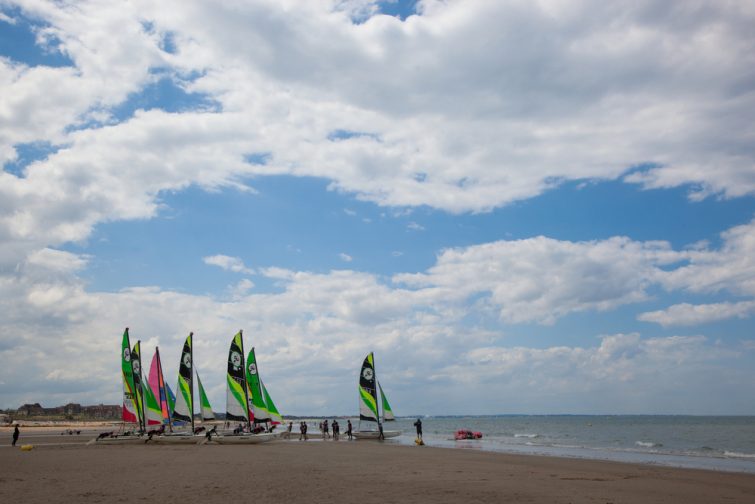
Crédit photo : Shutterstock – flydragon
Between Caen and Deauville, the "romantic beach" stretches over almost 4 kilometers of fine sand. Visiting Cabourg will give you the opportunity to practice sand yachting in Normandy, in a unique setting. The Grand Hôtel Belle Époque , the casino and the Marcel Proust promenade are all attractions that can be observed from the beach.
The seaside resort also has the Family Plus Label: clubs specially dedicated to children are installed on the beach. If you come with your family, you can let your children have fun during your initiation to your new favorite hobby! What a pleasure also to reward his sporting efforts by eating an ice cream at the end of the afternoon on the longest pedestrian promenade in Europe.
7. Ouistreham
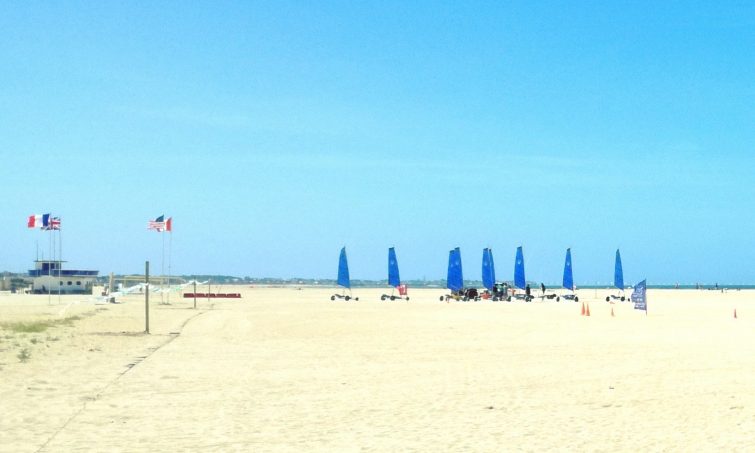
Photo credit: Facebook - Sweet Home Cabourg
Head for Ouistreham Riva-Bella beach! Labeled a 3-star Nautical Station, the Pearl of the Côte de Nacre is perfect for lovers of marine sports. Among the range of possible activities, sand yachting is a must.
Before setting off on the sand, take the time to observe the changing landscapes, capped by the dunes that separate you from the city…
8. Bretteville-Sur-Ay

Photo credit: Facebook - Ay-ole sand yachting center
Are you looking for a huge, wild and untouched place for tourism? Welcome to Bretteville Beach! Ten kilometers of beach between the two harbors of Saint-Germain-sur-Ay and Surville, a view of the island of Jersey : yachting aficionados will be delighted! The small town of Bretteville-sur-Ay is located on the D650, which locals also call the "tourist route".
From Cherbourg to Coutances, it runs along the Normandy coast and smells of holidays, the sun and the hot sand (in summer!). Taking this legendary route will take you to several sites of tourist interest ... and many sand yachting spots. Are you ready for the Normandy sand yachting tour?
9. The Bay of Mont-Saint-Michel

Crédit Photo : Shutterstock – 365_visuals
To practice sand yachting in Normandy in a mythical place, nothing better than the bay of Mont Saint-Michel. Very close to Mont Saint-Michel, on Hirel's shore, you will be introduced to the pleasures of sand yachting.
The session takes place in two stages: you will approach the sand yachting from a theoretical point of view during a briefing, then once the safety rules are understood, you can let yourself slip into this boat. Notice to thrill seekers!
Practical information for sand yachting in Normandy
The activity.
Sand yachting is a hobby where you seek both to gain speed and to steer your craft, propelled by the force of the wind. You quickly manage to control your little ship and gain a very pleasant feeling of freedom. The tank can be single or two-seater . The tandem version is particularly suitable for taking a child on their lap or for feeling reassured by the presence of an instructor.
The conditions of practice
The sand yachting is accessible to everyone , from 7 to 77 years old. It is best done at low tide, when the beach is huge and you draw lines on the still wet sand. A minimum force 3 wind is required to propel and steer. The ideal is also to ride on a very compact sandbank.
The equipment
For a successful session, bring warm clothes (sweater, fleece), an old pair of closed shoes, sunglasses and gloves. Generally, clubs provide helmets and waterproof clothing (coveralls, waxed). Also think about your change of clothes!
So what are you waiting for to make sand yachting in Normandy?

Land Sailing World Championship

The Land Sailing World Championship planned in Asnelles in 2024 is an event that highlights the importance and attractiveness of yachting as a sports discipline, but also its ability to bring together people from diverse backgrounds around a common passion for speed and technical mastery. More details on different aspects of this event are as follows:
**The Land Sailing Discipline**
Sand yachting, or land sailing, is a sport that consists of driving a three- or four-wheeled vehicle powered by a sail, on beaches or stretches of flat land. It is a sport that combines the finesse of sailing with the excitement of motor racing, offering a unique experience of speed at ground level, driven by the wind.
**The Asnelles Framework**
Asnelles and Gold Beach, where the championship will be held, offer a spectacular setting for this competition. These beaches, steeped in history, particularly in connection with the Normandy landings, offer ideal conditions for sand yachting: vast stretches of sand and regular winds. It is a place where the natural beauty of Normandy blends with history, creating an unforgettable backdrop for competitions.
**Participants and Spectators**
The event attracts top competitors from all over the world, each bringing their own techniques, experience and passion for the sport. For the spectators, it will be a unique opportunity to see up close the intensity of the competition and the mastery of the drivers. The initiations and demonstrations planned will also allow those new to the sport to discover it in an interactive and entertaining way.
**The Unique Experience**
Participating or attending the 2024 Land Sailing World Championship promises to be a memorable experience. Whether it’s for the thrill of competition, the beauty of the landscape, learning a new sport, or simply to enjoy the festive atmosphere, this event has something to offer everyone.
In short, the Land Sailing World Championship in Asnelles is much more than just a sporting event; it is a celebration of passion, history, and community that promises to be a highlight of the year 2024 in Normandy.
To learn more about the principles of Mailchimp's confidentiality policy: click here .
With your consent you keep as well the right to rectification of your personal data, the right to be forgotten and/or the right to erasure of your personal data.
- Tracking Cookies
- Google Maps

Visiting the beaches of Normandy: D-Day landings and WW2 sites – your ultimate guide
Visiting the beaches of Normandy, with its wealth of D-Day and world war 2 sites, was on our bucket list of things to do while in France and it’s one of those places that are well worth the visit.
They can be accessed easily from either the UK or other parts of France (and as such, the rest of Europe) and each year they get more and more visitors eager to learn of what happened on 6th June 1944, or as it’s now known – D-Day.
This article probably contains affiliate links. This means that if you buy or book after clicking, I may get a commission at no extra cost to you. Thanks!
I hope our guide to visiting these WW2 sites on the French coast of Normandy will be helpful and inspiring to anyone planning a visit and also anyone with a passing interest in our recent history.
Essentials for your D-Day explorations:
- Guide book with background info on the D-Day Sites
- Normandy Road map
Guided tour from Bayeux
- Half Day Small group tour to Omaha Beach
Our guide to visiting the beaches of Normandy and WW2 sites
The words have become almost normal now – incorporated into our everyday speech – D-day, beaches of Omaha, Utah, Sword, Gold and Juno. Strange to think that 100 years ago, these words meant nothing in the context that we now think of them.
That’s what’s so moving about visiting the beaches of Normandy , the fact that it was so recent, that there are still people alive who remember those days, lived through them and either were there themselves or heard the news about it. As time moves on fewer are around to tell the tale first hand, so it’s all the more important to keep the stories alive and to give weight to those words.

I knew of D-day, of course. I grew up with fairly limited knowledge of the history though, I had heard the term but only really learned about the operation when our son developed a passion about the time period. We watched films, documentaries and tv series about the war – I thought I knew what we were going to see when we visited Normandy!
What remains of World War 2 in Normandy today is sombre, touching and hopeful. Sombre because it was the scene of many deaths, not just fallen men, but brothers in arms (to coin a phrase), comrades and friends. Touching because there are still memories of a time gone by scattered around. Hopeful because it’s a reminder of what can be achieved by humans in the pursuit of a better world.
Pin for later!

It’s not all about the war in Normandy though. If you’re planning a trip with those who aren’t quite as interested, or perhaps with children who might not cope with days learning about death and fighting, the area has so much more too. Gorgeous little towns, beautiful scenery and of course that amazing French food!
Normandy Invasion – a super quick history
Ok, this will be quick as I imagine if you’re interested in visiting the Normandy D-Day beaches you have a slight inkling of the history involved.

It was one of the largest organised invasions of all time that incorporated naval, air and land troops and it was a turning point for the Allies in World War 2. The Normandy invasion on D-Day, 6th June 1944, were truly immense undertakings from the armed forces of not only Britain but also the USA and Canada.
Prior to it happening, France was under occupation from the Germans and their advancement throughout Europe was continuing. The Allies needed to have a foothold in Europe in order to have any hope of turning the tide. What’s interesting is that the Germans actually knew that an invasion was likely to be happening, but they didn’t know where from and where the Allies would land. There were many attempts to throw off the scent and the Germans did think the invasion would come further up the French coast in Calais or Dunkirk where it was much closer to the UK coast but of course that never happened.
It was so much more than D-Day itself though – there was months of preparation which included simulating the Normandy coastline in areas of the UK coast, practicing their manoeuvres and training the personnel. This was an immense undertaking. Further to this there was an operation whereby the coastal defences were bombed in advance of the invasion.
On the day itself, the Allies began by parachuting in airborne forces behind the enemy lines where they took strategic points and would meet up with the troops that began to land in the early hours of June 6th. They fought with the soldiers and guards of the Atlantic Wall that Hitler built. It certainly wasn’t easy but eventually they took the areas one by one, strategic towns and points were gained and the Allied forces pushed the Germans back.
Although the operation as a whole was a success there were many stories within D-Day where it seems the opposite. Many, many lives were lost on both sides which is a terrible tragedy no matter the outcome.
A note on the names of the beaches in case you don’t know.
There were many different areas of the coastline that troops landed on but they were generally split in to 5 sections and each had a different armed force in charge of landing there.
Each area was given a code name – Utah, Omaha, Sword, Gold and Juno. The Americans were charged with the Utah and Omaha landings. The British landed at Sword and Gold and Juno was mainly Canadians. The overall operation was called Operation Overlord and the landings themselves Operation Neptune.
The history of this time is vast and I’ve researched thoroughly for this article but I’m not a historian so please forgive me if there are any inaccuracies – and also let me know so I can put it right! For more in depth research of this time period Wikipedia is a good start and from there explore their related links at the bottom.

Why visit the D-Day beaches in Normandy?
Of course D-Day has been immortalised in films and tv series over the years and it’s one of the biggest and most well known operations from the Second World War.
It’s an iconic moment in history and one where we can look back and see the huge sacrifice that was made actually did make a difference. If D-Day hadn’t turned out as it did the outcome of the war might have been very different. As such it’s a huge part of our history.
I feel that we must always remember the sacrifices made for us and while watching documentaries, reading books and enjoying movies about it can keep the stories alive, visiting the sites really gives a new dimension.
You can know that soldiers lost their lives on a beach, but it’s just words. Seeing that area and visiting the nearby graves really brings home the personal sacrifices.
For many of us it’s important to visit because we have a personal connection to the day too. Many people come as a pilgrimage to pay their respects to family members who fought there.
For others, and I include myself personally in this, it’s just a really interesting place to go. This is recent history and an important piece of the huge story that is the second world war. No matter what I know about a place or piece of history I can’t fail to get something out of experiencing the place in real life.
Museums help to keep the information of each area in an organised manner and you’ll find many enthusiasts willing to speak to you about the history if you take the time to ask. By supporting these places you’re also helping to preserve the historic sites for future generations – definitely worth it.
Lastly, Normandy is a beautiful place in its own right. I’m focusing this guide on the D-Day beaches and the war history of the area, but there’s so much to enjoy here that’s not just war related so go enjoy the food, the countryside and the people too!
What are the Top 10 must see sights at the D-Day Normandy beaches?
Here’s the places you really shouldn’t miss on your tour of the D-Day beaches in Normandy – I’ve listed them in order from west to east rather than importance:

The first beach that you’ll get to if you are coming from Cherbourg or doing the tour West to East is Utah.
This beach was landed by American troops and was the more successful out of the two the US were dealt. The reasons are most likely geographical, the Germans were defending a wide open coastline here, flat with no difficult to reach areas they could attack from. Overall there were less than 200 casualties for the Allies here and it was a relatively quick victory.
Utah beach is one that isn’t in a built up area and the beach itself is nice to walk along if you get good weather with many remains of the German defences scattered along and lots of monuments to the battalions and units present there. There’s also a museum which attracts most people with an interest in the time period and is fairly inexpensive.
Utah Beach Landing Museum – learn about the chronology of the landings, see a B26 bomber.
Winter opening hours (Oct 1st – May 31st): 10am – 6pm. (It is closed for the majority of December, opening from the 26th – 30th only)
Summer opening hours (June 1st – Sep 30th): 9.30am – 7pm
Get tickets here
Sainte-Mère-Église
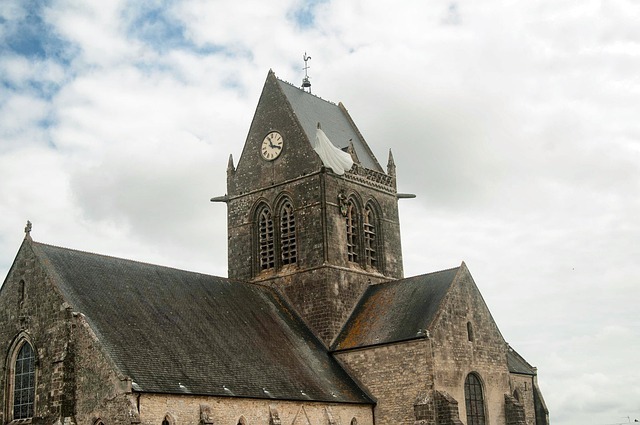
A big part of the operation at Utah beach was the destruction and capturing of many of the strategic points in the area from the airborne divisions who landed at various places including Sainte-Mère-Église, a small Normandy town.
Some of the 82nd Airborne division landed at Sainte-Mère-Église in the very early hours of the 6th of June 1944, unfortunately too close to where they planned to land. Many of them died as some buildings on fire in the town lit up the parachutists descending and were easy targets for the Germans. One interesting tale is about the soldier, John Steele, who found himself caught on the steeple of the church as he tried to land. He was shot in the foot, in lots of pain and could only watch some of the others in his company as they were killed. He dropped his knife so could not free himself and so had to pretend to be dead while the fighting was going on around him. He eventually was rescued from his precarious position by the Germans and he became a prisoner of war until he escaped a few days later. Despite early German dominance the town of Sainte-Mère-Église was taken soon after on June 7th 1944 and it also has the honour of being the first liberated town of the Normandy invasions.
In the town itself there’s a museum dedicated to the 82nd and 101st Airborne division – if you’ve watched Band of Brothers, 101st Airborne is portrayed in it.
It’s well worth spending some time there with plenty that will keep kids happy (both of mine enjoyed their time there) and provide an insight in to what happened in the area for those interested to learn more. Lots of replica planes and gliders to get a sense of what was involved!
The church keeps the story of the parachutist alive by keeping a fake dummy of a soldier on its roof top.
It’s a pretty town to explore round with many tourist shops selling world war 2 memorabilia, some restaurants and cafes too. We really enjoyed our time there.
Airborne Museum – learn about the airborne attack, how they liberated the town and also see some of the gliders and planes used.
Opening times:
- May – Aug: 9am – 7pm
- April and September: 9.30am – 6.30pm
- October – March: 10am – 6pm (the museum is closed throughout December and January)
See here for more information
Pointe du Hoc

One of the areas of Normandy that remains much as it was during the time of the landings is Pointe du Hoc. It’s a steep cliff edge and the highest point of the area which sat between the beaches of Utah towards the East and Omaha which lay to the west. As such it was heavily fortified and protected by the Germans despite it having been bombed prior to D-Day.
The United States Army Ranger Assault group were charged with the scaling of the cliffs at Pointe du Hoc and removing the German artillery with the help of the British to land them at the scene. Before even landing there were problems straight away with the sinking, and subsequent loss of those on board, of one of the amphibious DUKW vehicles. On landing the Germans fired heavily on all of the troops with disastrous effect and on reaching the base of the cliffs the Rangers were at half the initial numbers. To reduce the risk of them being fired at as they grappled up the cliffs, navy ships from the US and British navies fired on the German defences. On reaching the top the soldiers struggled with yet more set backs: their radios didn’t work and their objective of removing a main artillery defence was already gone. After intense fighting the finally overpowered the remaining guns and destroyed them. They held off lots of counter attacks from the Germans over the next couple of days until they got relieved by further US troops on the 8th June.
Pointe du Hoc is one of the stories I personally didn’t know much about but which I’m so glad I learned about.
The museum at Pointe du Hoc does a really touching video which explains what happened. Reading about the words often don’t convey the sense of what happened, but listening to the stories from the soldiers who scaled the cliffs themselves, watched their friends get fired upon and who came home to tell the tale brought tears to my eyes.
There’s lots to see at Pointe du Hoc as well as the visitor centre – the remains of the casemates built by the Germans can be explored and you can imagine how it might have looked to them as the enormous amounts of D-Day troops descended on the area. Craters litter the site too where it was heavily bombed.
Visiting Pointe du Hoc
Open daily throughout the year
- April 15th – September 15th: 9am – 6pm
- Rest of the year: 9am – 5pm
Pointe du Hoc is one of the few free things to do in Normandy related to WW2 – if you’d like more information about visiting see here .

Maisy Battery
I have such a soft spot for parts of history that are covered over and forgotten about for years and Maisy Battery is one such place.
It was a very important German defensive position situated between the Utah and Omaha beaches and consists of over 2 miles of tunnels, bunkers and trenches. The history of the site is still coming to light with all the war documents being released over the years – it seems that it was an unknown site to the Allies and that the Germans used Pointe Du Hoc as a ruse to confuse them and with the removal of the big guns that were expected to be there, this could certainly be true. It was lost to the world for over 60 years and was only rediscovered as someone found an old map to it in a veteran soldiers trousers. That discovery combined with the opening of war files has opened up an exciting and interesting chapter!
If you drive past you might miss it – it’s completely camouflaged from the casual viewer! Nowadays you can walk round the site, explore the tunnels, see some old guns, cannons and weaponry. It’s a great day out and quite different to many of the other WW2 sites around Normandy.
Visiting Maisy Battery
Opening times
- April 1st – May 31st: 10am – 4pm
- June 1st – Aug 31st: 10am – 6pm
- September 1st – September 30th: 10am – 4pm
- Closed from October – March (although you can contact them with a possibility of visiting)
See here for more details and tickets
Omaha beach

The US Army had the objective of securing the Omaha beachhead however a catalogue of mistakes and confusion led to this being an extremely difficult operation with huge numbers of soldiers losing their life. It started with the naval bombardment of the German defences – it wasn’t enough as they navy didn’t want to risk hitting the landing crafts. The landing troops were also blown off course quite a lot on the morning of the invasion due to the weather and this did not help matters. The intelligence about the defences were flawed, they had trouble bringing vehicles on land with many of them being swamped as they tried to land and finally many of the soldiers were wiped out as soon as they did land due to heavy gun fire from the Germans. As many as 2000 lost their lives (some sources report up to 5000) on that day. After many days of fighting the objectives were completed, the beach secured and it was eventually used as a harbour to bring artillery and troops in to France and to help the push against the Germans.
Nowadays there’s a few remnants of the war still visible. There’s many monuments to the regiments that fought along this stretch of land and who also lost lives as well as a memorial museum. At low tide you might also be able to see the remains of the harbour that they built but not as prominent as the one at Arromanches.
Omaha Beach Memorial Museum
- February: 10am – 5pm (opens mid February – check their site for dates if travelling round then)
- March: 10am – 6pm
- April – May: 9.30am – 6.30pm
- June: 9.30am – 7pm
- July – August: – 9.30am- 7.30pm
- September: 9.30am – 6.30pm
- October – November: 9.30am – 6pm (closes mid November)
- Closes from mid November – mid February.
See more information here
American cemetery

Overlooking the beach at Omaha is the American Cemetery which holds a great number of US soldiers who died in the second world war and with many of them being in the time of the Normandy landings. It’s a beautiful place which overlooks the sea and it’s a heartbreaking visual reminder of the loss of life suffered.
Of course, it’s not the most cheery of places to visit and we couldn’t stay long as our daughter didn’t want to go (always something to bear in mind when visiting these WW2 sites with kids) but it’s a very important place that should be included in your itinerary if you can.
There’s a visitors centre there too which tells the stories of the soldiers and is free to enter.
Normandy American Cemetery Visitor Centre
Admission is free – see more info about the site here
Gold beach & Arromanches sur les bains

This was my favourite site of our trip (see below for our thoughts on what to visit if you can only visit one beach) and it provides lots for anyone visiting Normandy with hopes of seeing WW2 history – there’s lots still visible!
The landings at Gold beach are slightly to the east of Arromanches and this was on of the two beaches that was taken by British troops. The day started like many of the others with bombardment and bombing of the area the night before and the troops landed in the early hours of the morning of 6th June. Choppy and rough seas meant that like many other beaches the men landed slightly off course and the vehicles they tried to bring ashore would get bogged down in the sand. There were many casualties at Gold with around 1000 reported. At the end of the day, almost 25,000 troops landed, they took Arromanches and eventually used that site to build a mulberry harbour which allowed them to bring in more weaponry to mainland Europe for the rest of the war.
There’s lots to see at this area. We really enjoyed our visit to the town of Arromanches-sur-les-bains as you can see lots of the remains of the mulberry harbour. This was the temporary harbour that was built to move tanks, weapons and soldiers in to the country. There’s also a really good museum in the town too which I recommend to learn more about this area and how they landed and used the town. Longues-sur-mer battery is also a well preserved German defence area that is worth visiting if you’re around this section.
Longues-Sur-Mer Battery
Freely open to look around – there are guided tours as well at the following times of year:
April, May, June, September & October: weekends only
July & August: daily
Tours run in both English and French – see here for more details.
Musée du Débarquement / D-Day Museum in Arromanches – learn about the mulberry harbours and the d day landing beaches
- January: Closed
- February: 10am – 12.30pm & 1.30pm – 5pm
- March: 9.30am – 12.30pm & 1.30pm – 5.30pm
- April: 9am – 12.30pm & 1.30pm – 6pm
- May – August: 9am – 7pm
- September: 9am – 6pm
- October: 9.30am – 12.30pm & 1.30pm – 5.30pm
- November & December: 10am – 12.30pm & 1.30pm – 5pm
See here for more details

The responsibility of the Canadian army was Juno beach which was located inbetween Gold and Sword. The familiar story of the sea conditions causing delays and problems to the landings also applied here and the beaches were heavily protected by the Germans. Although there was a preliminary bombardment of the sites they weren’t very effective and as such the troops landing were under heavy fire from the very start. It’s considered one of the more successful landings, alongside Utah, even though many of the objectives weren’t actually met. Casualties were relatively low, around 340 dead on the day.
One of the towns in the area, Courselles-sur-Mer, now features a museum and memorial called the Juno Beach Centre. If you’re at all interested in the Canadian effort in the war as well as the specifics of the Juno landings then I’d highly recommend a visit.
Juno Beach Centre
- January: closed
- February: 10am – 5pm
- April – September: 9.30am – 7pm
- October: 10am – 6pm
- November- December: 10am – 5pm
Get more information here .
Sword beach & Pegasus bridge

The final beach going from west to east is Sword beach at the town of Ouistreham.
Sword was the responsibility of the British army and although the experienced quite a few casualties on landing at the beach, they managed to get their armoured vehicles landed quickly and took the beach in fairly good time. This beach was the closest to Caen which was a major objective in Operation Overlord and so the troops moved onwards to there but suffered lots of setbacks and resistance on the way. Another important place nearby is Pegasus Bridge which played a part on the night before the landings where the plan was to secure the bridge and prevent any further German troops from gaining access to the bridge and hindering the landings the day after. They arrived by using gliders successfully taking the Germans by surprise.
Sword beach was the first that we visited and it’s very strange, yet happy place that is a completely normal beach town. Not what we were expecting at all. There were people playing on the beach, lots of land sailing going on and just a generally nice atmosphere.
The town of Ouistreham is a pleasant town to spend a night as well with lots to see if you’re interested in the landings. There’s the Grand Bunker museum which is well worth a look, No4 Commando museum and also the Pegasus bridge memorial too all within that town.
Grand Bunker Museum, Ouistreham – see the command post as it was and learn about the Atlantic Wall
- Jan 6th – Feb 8th: Closed (2019 dates)
- Feb 9th – March: 10am – 6pm
- April – September: 9am – 7pm
- October – January 5th: 10am – 6pm
See here for more information
Pegasus Memorial Museum
Open every day from 1st February – 15th December
- February – March: 10am – 5pm
- April – September: 9.30am – 6.30pm
- October – 15th December: 10am – 5pm
See here for more information.

Though not a beach, a major player in the Battle for Normandy is the city of Caen which suffered terribly in the days after D-Day. It was actually in the plans for it to be captured on D-Day itself, but that never happened, the Germans defended it fiercely and what ensued was fierce fighting and many casualties on both sides and civilians. It actually took around 7 weeks for the city to be taken and ended with a bombing from the Allies which killed many French citizens and completely destroyed the city, reducing the majority of it to a pile of rubble.
Caen has many memorials about WW2 but the main one is the Memorial de Caen which houses a really good museum which is worth checking out. If you are in the area do also check out the Abbey d’Ardenne which was the site of an atrocity committed by the Germans against some Canadian soldiers they had taken as prisoners. At least 20 soldiers were executed there and there’s a touching war memorial to the men.
Caen Normandie Memorial Museum
- February – March: 9am – 6pm
- October – December: 9.30am – 6pm (some Mondays are closed also in this time)
See here for more information and tickets
Tips for visiting the Normandy WW2 sites
- Winter sees lots of the sites close for the season – do be aware of this if you are coming in the winter months. If sites are open their hours are reduced a lot too. Although out of season is generally a good time to visit, do make sure what you want to see will be available. January sees many of the museums close completely so I’d recommend not to visit that month at least.
- It rains. A lot. We were there for about a week in April and saw so much rain! Later we learned that Normandy is a very rainy region and is well known for it!
- As these are war graves, dress and act respectfully
- Around D-Day itself many of the sites close for ceremonies and it will be much busier so if you’re visiting around then check individual sites and book well ahead.
- France is well known for long lunch hours – as you’re visiting the towns and villages around be aware of this and don’t be surprised that shops shut.
- Sundays are also a day when almost everything shuts (although the D-Day museums around here tend to be open) – get any supermarket shopping done in advance. We were definitely taken by surprise by this on our first visit to France!
What Normandy WW2 museums are worth visiting?

There are many museums along the coast line and in towns, too many really for one trip. Unless there’s a specific area or operation that you’re interested in I’d suggest heading to wherever is convenient for you and enjoying what is on offer there. There’s a chance of information overload if you try to do too many.
I mean, how many guns can you see without getting bored? My son would probably argue with me about that!
We haven’t visited all the museums in the area (unfortunately!) but we did enjoy the D-Day museum in Arromanches as well as the Airborne museum in St Mere Eglise and I’ve heard good things about all the museums in Normandy.
How long should you spend in Normandy?
If you’re planning a Normandy trip I’d say that a good time to take in the sites is around 3 or 4 days. This would allow you to really see all the beaches, plenty of museums and other sites around the area and for you to take in the larger towns such as Bayeaux and Caen.
More than this and I’d imagine that history overload might take over, but your mileage may vary!
If you want to incorporate checking out the rest of the area including the gorgeous Mont St Michel then I suggest as long as you can spare and at least a week! France is a great place to visit and we enjoy the slow pace of life there a lot! Try not to rush your time there.
You can only visit one beach – which one?
This is a difficult one to answer and each person in our family who I asked said a different place.
I think this can possibly depend on your war knowledge or maybe your heritage – Americans will almost certainly say Utah or Omaha, Canadians will say Juno!
Personally I found Gold beach and specifically the town of Arromanches to be a really special place to visit and this is coming from someone with only basic knowledge of what happened in Normandy in WW2. With parts of the artificial harbour still in view and being able to be seen up close, it really helps you visualise what happened back then. Obviously if you can, visit at least a couple, but if I had to choose just one it would be the area around Arromanches-sur-les-bains.
I asked my son (our resident WW2 nut – he knows way more than me!) for his opinion and he said Omaha due to the extreme loss of life there and the significance of that beach in later films so that would be my second choice. You also have the American Cemetery nearby too so easy to incorporate that in to your day.
My husband said to visit Pointe du Hoc. I know, we’re not very helpful in narrowing down the choices!
If you are pushed for time, consider what is important for you to see. If you’re British and want to see the places that they fought concentrate on the middle to east part. If you’re Canadian you’ll likely want to concentrate on the Juno area and if you’re American or interested in the infamous Bloody Omaha then you’ll want to stick to the west.

Interested in more WW2 travel? See our posts about London’s WW2 sites or visiting Colditz Castle in Germany
Getting to the Normandy beaches
How to get to the normandy beaches from the uk.
Update – check out our new post about getting to Normandy from UK
When we travelled we took our motorhome over on the Dover to Calais crossing with DFDS (always the cheapest option when I check) and travelled down from there. It was a fairly straightforward journey but one thing I’d say is to not underestimate the time it can take to get to places in France. It never looked too far on the map but it can be especially if you’re not using the motorways.
If you want to get yourself right in the heart of Normandy straight away and keep journey times to a minimum then I recommend a ferry to Cherbourg which means you can start at the Western end of the beaches near Utah within around 45 mins drive of the port. Alternatively you can get a ferry to Le Havre which is about an hour and a half from Ouistreham and the eastern end of the beaches or Dieppe which is just over 2 hours drive away.
Brittany ferries – goes to Caen, Le Havre and Cherbourg
DFDS – goes from Newhaven to Dieppe
P&O ferries is another option to Calais
Looking for an itinerary for your trip? Check our 3 day self drive Normandy D-Day itinerary
There are also many tours that depart from the UK if you want to visit but aren’t too keen on doing it independently. My Father in Law took a coach trip a few years back and thoroughly enjoyed his time there and it’s a great idea if you want to just sit back and enjoy your time there.
How to get there from Paris
If you are arriving in Paris and want to incorporate the beaches in to your France itinerary then I suggest one of two options: either hire a car or arrange a place on guided tour.
It’s around a 3 hour drive to Ouistreham on the most eastern end of the landing sites so doable as a day tour if you wanted to, although it would be a long day. To check out rental car options I recommend DiscoverCars.com which compares many companies to find the best deal.
Guided tours from Paris to Normandy are plentiful from the capital with some taking in the area over a couple of days and others just doing a day trip.
When looking at these tours bear in mind if you have any specific places you want to visit and see if they include them as it’s impossible for them to cover everything!
This one is a good option and if you have a couple of days to spare this one is worth a look and even covers other Normandy sites such as Mont Saint Michel.
Visiting the beaches from Le Havre
Many cruise ships stop in Le Havre and as such it’s a good place to get excursions to the beaches. Here’s one that covers many areas in a day.
Canadian sites from Le Havre
US sites from Le Havre
Using public transport to visit the Normandy beaches
It’s not particularly easy to use public transport to get to all the sites in Normandy but with some planning you should be able to visit a few places.
Caen is an important part of the invasions and is worth seeing if you can. Trains are around 2 hours from Paris in to the city. If you want to do a tour from Caen this one would be worth checking out.
Bayeaux is another good town to visit and easily reached by train as well. From Paris it can take between 2.5 and 3 hours to get there and it’s also easily reached by Cherbourg in about 1 and a half hours if you happen to be a foot passenger on one of the ferries.
Tours from Bayeux
There are many tours from Bayeaux that can take you on to the beaches themselves and are a better option that trying to navigate the buses which are infrequent.
US Sites tour
US and British sites
Canadian sites tour
Driving tips for France
If you decide to drive over in France then here’s just a couple of tips:
- make sure you have a european driving kit that covers you for the legal things you need in France – Hi vis jackets, headlight deflectors (if coming from the UK),
- the motorways in France are often toll roads and it can add up over time. Either be prepared for this or plan a route that avoids them.
Where to stay when visiting the Normandy beaches
Bayeaux is a perfect base for any tour to the beaches whether it’s self drive or going by guided tour. I’ve linked below to a couple of options with Booking.com – they are my preferred booking portal as often you can book without needing a deposit and they are super easy to use.
If you want to stay in the centre of town itself, be close to the town’s attractions such as the Bayeaux Tapestry (ok, now WW2 but still pretty cool) then I suggest the Hotel du Luxembourg which comes highly recommended. It does have parking, although there’s a charge of €9 a day so do bear that in mind. Check the hotel out here .
A budget option in Bayeux would be the Ibis hotel with free parking on site – here’s some more information about it .
Campervan and motorhome travel in Normandy
If, like us, you decide to take your motorhome to Normandy then you’re in for a treat as France is amazing for free or low cost camping areas (called Aires) in towns and villages all round the area.
I think we managed pretty much not paying anything for the whole of our journey except for one night on a campsite. I recommend getting the book All the Aires which gives all the information on where to stay and what facilities are available.
What next? Get inspired with movies, tv shows and books: Band of Brothers Saving Private Ryan D-day audio book Start planning your WW2 France trip with these guide books: Lonely Planet Normandy Travel the Liberation Route Book your hotel in Normandy: Booking.com
You might also like :
- Visiting Sherwood Forest: See Robin Hood’s Tree hideout – the Major Oak
- 5 gorgeous hotels overlooking Edinburgh Castle
- Our Texas to California Road Trip itinerary with 1000 miles on Route 66
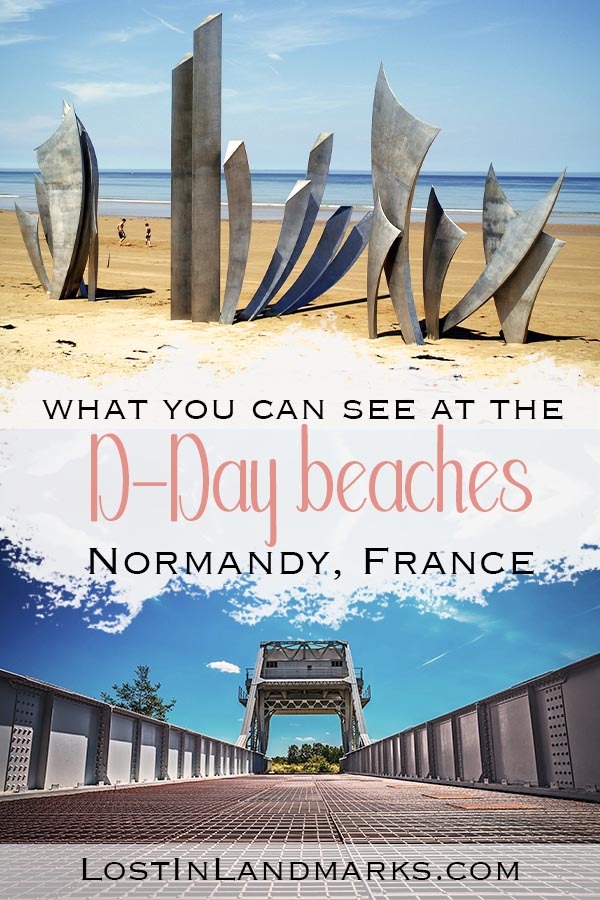
Kirsty Bartholomew
2 thoughts on “Visiting the beaches of Normandy: D-Day landings and WW2 sites – your ultimate guide”
Opening times typically range from 9-10am to 5-6pm, but daylight stretches much further. Therefore, my usual question: which beaches/sites can be acceptably experienced outside 9-18 time bracket?
Good question Pablo – all the beaches are accessible outside of opening times for the visitor centres. I would say to perhaps look at the tide times especially for beaches like at Arromanches as when the tide is out you can walk up to the pontoons but of course when it’s in they are covered. BUT definitely don’t let the fact that the visitors centres not being open deter you from going. Plenty to see!
Leave a comment Cancel reply
- Skip to primary navigation
- Skip to main content
- Skip to primary sidebar
- Skip to footer

Normandie Lovers
To awaken your senses in Normandy - Claire et Manu’s Blog
Visiting the 5 D-Day landing beaches (in Normandy)
by Claire ROBINSON , Region Lovers | September 7, 2023 | no intrusive ads, no sponsored content, just some affiliate links - if you use them, we get a small commission (read more)
Sand, dunes, cliffs… but also bunkers, sculptures and museums. The 5 D-Day landing beaches are a must for any trip to Normandy. Their story is both heartbreaking and inspiring. Each of these beaches now has memorials and museums to remember. Here is our complete guide to prepare your visit with:
- Omaha Beach
- Sword Beach
BEFORE OUR TIPS + PHOTOS HERE ARE OUR favorites

Our favorite car rental platform with great offers: DiscoverCars

Must-See : Book your tickets for the Caen Memorial Museum Excursion : Visit the D-Day landing beaches from Paris

Our favorite places to stay: Hotel Domain de Bayeux , elegant and central – see photos and availability Hotel Domaine d’Utah Beach , for the north – see photos and availability Hôtel Ferme de la Rançonnière , the charm of the countryside – view photos and availability
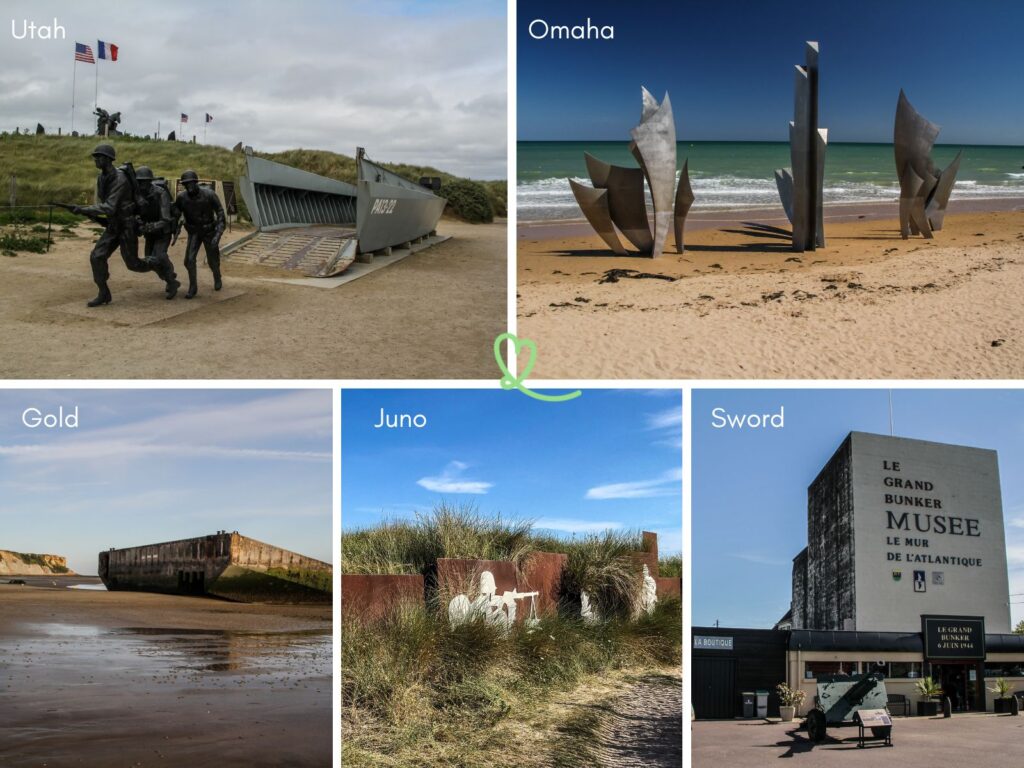
This guide is completely independent , based on our experiences. We visited the area anonymously, making our own choices, and paying all our bills in full.
Visit the D-Day landing beaches in Normandy : Map + tips
The 5 landing beaches – map and introduction.
Operation Overlord, a.k.a. the Normandy invasion, began on June 6, 1944. 5 main areas were strategically chosen by the Allies on the Normandy coast. They cover a section of more than 80km (50 miles). Code names have been given:
- Utah Beach, the easternmost beach where the American troops landed
- Omaha Beach where the American troops landed
- Gold Beach where the British troops landed
- Juno Beach where the Canadian troops landed
- Sword Beach where the British troops landed
Here is a short introduction video of each track:
The Battle of Normandy that followed lasted until the end of August.
Here is a map to help you locate them:
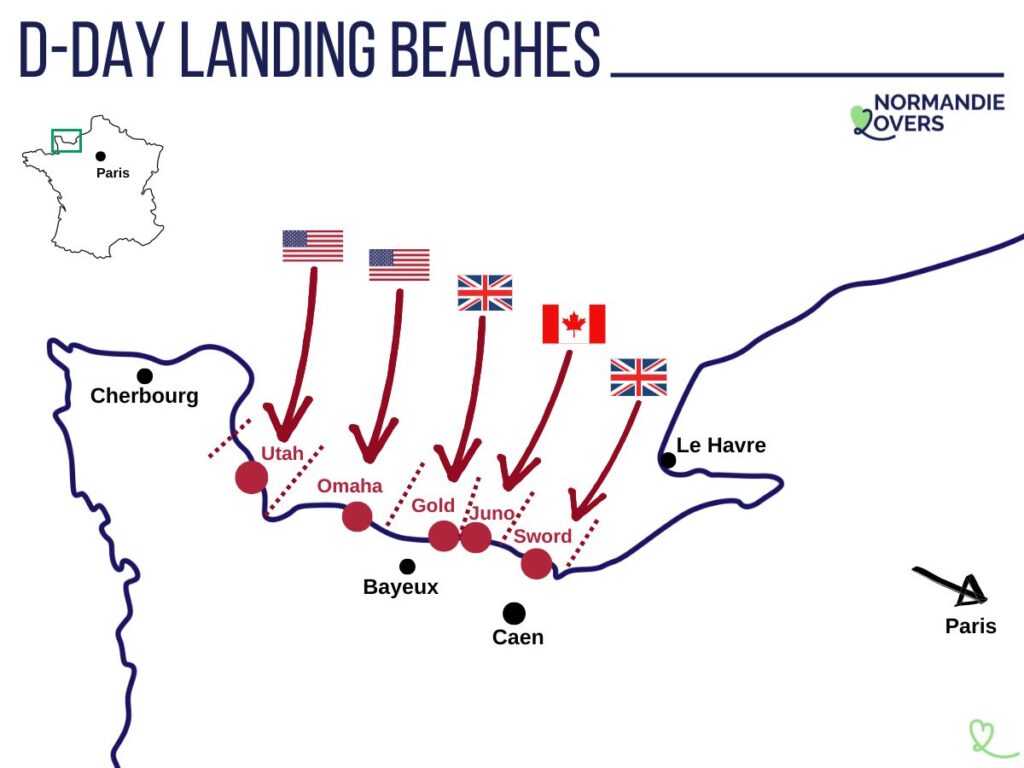
Which D-Day beach to visit?
Around these 5 beaches, you will find cemeteries, batteries, memorials and museums. They are all fascinating to discover. Depending on your family history, you can choose the one that interests you the most. And if you don’t know about special family ties, here are our opinions to help you choose:
- Utah Beach is the most fun : an open air museum, a battery and the new D-Day Experience not far away
- Omaha Beach is the most emotional : the magnificent sculpture on the beach, the intensity of the American cemetery. We didn’t expect to feel so many overwhelming emotions as we stood in front of all these crosses lined up.
- Gold Beach is the most fascinating visually: the remains of the temporary harbor that appear at low tide, the view from the cliffs…
- Juno Beach is the quickest to visit – if you’re short on time, the beach and museum are right next to each other
- Sword Beach is the most strategy oriented – no beach experience here, but the Antaltic Wall Museum in the Bunker is a unique experience and the Pegasus Memorial tells us more about this critical victory.

How to visit the D-Day beaches in Normandy?
We do not recommend public transportation to visit the landing beaches. There are some local buses, but not very frequent and with many stops for the locals. Your best options are:
- By car Visiting by car gives you a lot of flexibility in choosing where to go and how much time to spend at each place. You can rent at CDG or Orly airports, or Caen (see our tips ) or your point of arrival in France – note that Bayeux has very few choices (read more ).
OUR ADVICE FOR RENTING A CAR IN Normandy
- Compare prices on our preferred platform: DiscoverCars – one of the best rated sites.
- Choose a car that is comfortable enough (distances can be long) but compact (some parking lots and villages are narrow).
- Think of the complete insurance (some roads are tortuous and narrow).
- There is a lot of demand, book it early .
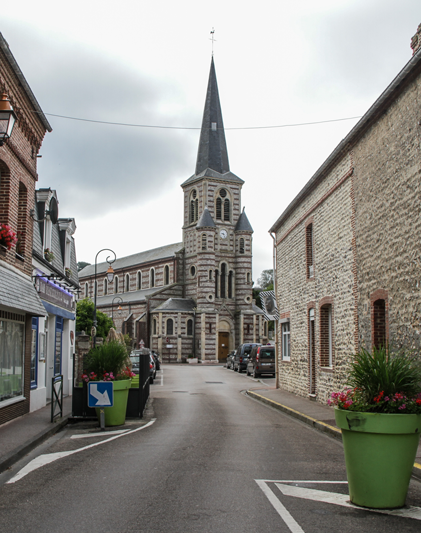
How long to visit the landing beaches
Let’s start by discussing a little bit about the driving times between locations. This will give you an idea of what is feasible:
- From Caen to Bayeux = 30 min drive
- From Bayeux to Utah Beach = 50 min
- From Utah Beach to Omaha Beach Beach = 45 min
- From Omaha Beach to Gold Beach = 45 min
- Gold Beach to Juno Beach Beach = 15 min
- From Juno Beach to Sword Beach Beach = 30 min
- From Sword Beach to Caen = 20 min
- Paris to Omaha Beach = 3h30
You can get an overview in one day. But for a more complete vision and to immerse yourself in the history we recommend 3 to 5 days, or even a week if you are passionate.

Which city is the most convenient to visit?
The most convenient cities to stay and visit all the landing beaches are :
- Bayeux, a charming little town inland see the best hotel offers
- Arromanches-les-bains, central and at the seaside, it is at the level of Gold Beach see the best hotel offers
- Caen is the largest city in the area see the best hotel offers
STAYING NEAR THE D-Day beaches
Option 1: Bayeux
The most practical option, in our opinion, is to base ourselves in the town of Bayeux. We recommend..:
- Hotel Domaine de Bayeux in an 18th century mansion – see prices, photos and availability
- see all top rated accommodations in Bayeux

Option 2: in the countryside
In the countryside around the D-Day beaches, you will find beautiful buildings with a lot of charm: farms, manors…
- Hotel Domaine d’Utah Beach – prices, pictures and availability
- Hotel Ferme de la Rançonnière – prices, pictures and availability

Option 3: next to one of the beaches
If you’re looking for a seaside holiday or are fascinated by one of the beaches, you can choose a more specific hotel:
- Hotel Villas d’Arromanches in Gold Beach Beach – prices, pictures and availability
- Hotel La Sapinière in Omaha Beach Beach – prices, pictures and availability

See all our advice on where to stay to visit the beaches
1. Utah Beach
The landing at utah beach – facts and figures.
Utah was the westernmost beach of the landing. It covered the section between Pouppeville and La Madeleine with the sub-areas Tare Green, Uncle Red and Victor. The section is 3 miles long (about 5km). 23,000 American troops landed here. Casualties were the lowest with 187 men killed or wounded.

Visit to the beach
The beach is easy to visit with a small dune, viewpoints and a large stretch of sand at low tide.

Barges and mannequins are installed not far from the museum, which allows to visualize a little better what the landing was like. But it’s hard to imagine this peaceful view with the sounds of gunfire, explosions and all the warships in the sea.

A little further down the beach, there are also some bunkers.

Museums around Sainte-Mère-l’Église
The main museum is the Utah Beach Landing Museum right on the beach. It tells in 10 sequences the events of D-Day. It is a chronological journey from preparation to victory. Open all year round

But the region is full of other museums and sites:
- The Airbone Museum with a superb scenography to understand the experience of the parachutists on the day of the landing Closed in December and January except during school vacations
- The D-Day Experience : an immersive museum with flight simulator Open all year round
- The Azeville Battery with an impressive underground complex Open from April to November 11
- The Normandy Victory Museum , about the Battle of the Hedges Open from April to October and partially in winter (weekends and vacations)
See more activities at Utah Beach .

Practical information to visit
Utah Beach is the most remote and scattered of the beaches. The museums are along the beach, in Sainte-Mère-l’église and in Carentan. You should plan at least one day but 2 days will allow you to cover more places. We stayed at the Domaine Utah Beach – Le Grand Hard hotel: a beautiful 17th century farmhouse turned charming hotel, with a restaurant known for its quality meat. A great time surrounded by nature! See photos, prices and availability Otherwise, there are hotels all around Sainte-Mère-l’église – see the best rated hotels aroundUtah Beach
USE OUR GUIDE TO PLAN A DREAM TRIP TO Normandy
All the information you need for your trip:
- 8 maps that make planning easier
- 160+ pre-selected locations
- Practical advice
- 300+ photos to help you choose
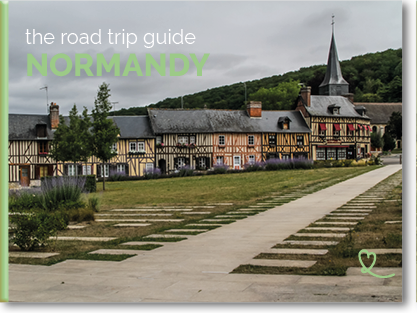
2. Omaha Beach
The landing at omaha beach – facts and figures.
Omaha, the largest, is probably the best known of the D-Day beaches. It covered the section between Sainte-Honorine-des-Pertes and Vierville-sur-Mer, with the sub-areas Charlie, Dog, Easy and Fox. The section is 6 miles long (about 10 km). 34,000 American troops landed here. Losses were highest, with 2,400 killed.

Omaha Beach is the most difficult to visualize. The beach has a promenade right on the edge and is very touristy with bathers. It is still one of the most photographed with the sculpture “The Braves”. It is composed of 3 elements: “Wings of Hope”, “Stand Up for Freedom” and “Wings of Brotherhood”. Created by Anilore Banon, it was installed in 2004, for the 60th commemoration.

The only signs of the war are the memorials and some bunker ruins.

Museums near Colleville-sur-Mer
- American Cemetery: 9387 perfectly aligned tombstones, garden, chapel, memorial, and a small museum giving the content of Operation Overlord. Open all year round
- Overlord Museum: near the American cemetery, one of the richest in terms of artifacts of the landing and the war. With a museography adapted to children. Closed in January and early February.
- The Pointe du Hoc: a strategic place of the German fortifications. The walk around the point takes you to see different bunkers above the cliffs. Open all year round
- Big Red One Assault Museum : museum dedicated to the 1st Infantry Division of the U.S. Army nicknamed “The Big Red One Open from March to November
- Maisy Battery : Battery rediscovered in 2006 with many underground passages. Open from April to September
- D-Day Omaha Museum – open from April to September
- Liberation House – open from May to September
- Omaha Beach Memorial Museum – open from June to September
Find out more about activities around Omaha Beach .

Omaha Beach is less remote but still requires a bit of a drive from Caen. The beach and the museums are grouped together, but to visit the Pointe de Hoc and the Maisy battery, you have to drive a little. You should plan at least one day but 2 days will allow you to cover more places. We stayed in Bayeux (25 min drive) at the Domaine de Bayeux: a charming hotel in the center of Bayeux surrounded by a French-style park. See photos, prices and availability Otherwise, there are hotels all around Colleville-sur-Mer – see the top rated hotels aroundOmaha Beach

MORE ABOUT THE D-Day sites
- The best landing sites to visit
- Visit the 5 D-Day landing beaches
- Where to stay – best hotels near the beach
- The best D-Day museums in Normandy
- German batteries to visit
- Car rental tips: Caen – Roissy-CDG – Orly – Beauvais
- Visit Omaha Beach
- Visit Utah Beach
- Visit Gold Beach
- Visit Sword Beach
- Visit Juno Beach (coming soon)
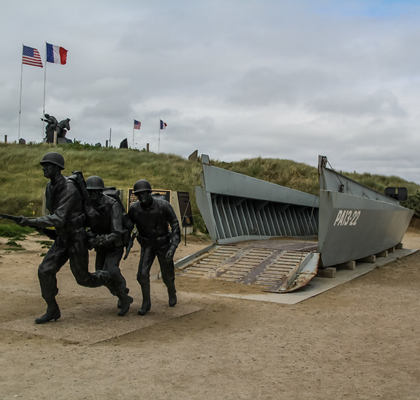
The Arromanches part of Gold Beach is one of the most visually interesting of the D-Day landing beaches. At low tide, pieces of the artificial harbor (Mulberries) appear clearly and you can approach them.

The beach of Arromanches is surrounded by cliffs. This allows to have beautiful views from the top of them.

And at the entrance to the beach, near the museum, you can appreciate several pieces of equipment.

Museums in Arromanches
- The D-Day Museum : presentation of the history of the British artificial harbor with the challenge of its construction and its key role in the victory. Closed in January
- The circular cinema Arromanches 360 : with 9 circular screens, the film “100 days of Normandy” plunges you during 19 minutes in the heart of the terrible battle. Closed in January
- The battery of Longues-Sur-Mer : a superb site on the cliffs with access to a fire command post, 4 reinforced concrete casemates and artillery pieces. Accessible all year round
- America Gold Beach Museum : dedicated to the first USA-France airmail link and the British landing in the “King” sector. Open from March to October
- Museum of underwater wrecks – open from June to September
Find out more about activities around Gold Beach .

The beach of Arromanches is very central. It is a good base to visit the landing beaches. The beach and the museums are grouped together. And the battery is only 15 minutes away. It is necessary to plan at least one day and to organize to visit the beach at low tide. We stayed at the hotel Les Villas d’Arromanches: a charming hotel in a 19th century villa on the heights of the city. A haven of peace with beautiful views of the sea. See photos, prices and availability Otherwise, there are hotels all around Arromanches – see the top rated hotels around Gold Beach

Subscribe to our Newsletter
- Get away from it all with Region Lovers’ beautiful destinations!
- Once a month
- Advertising-free
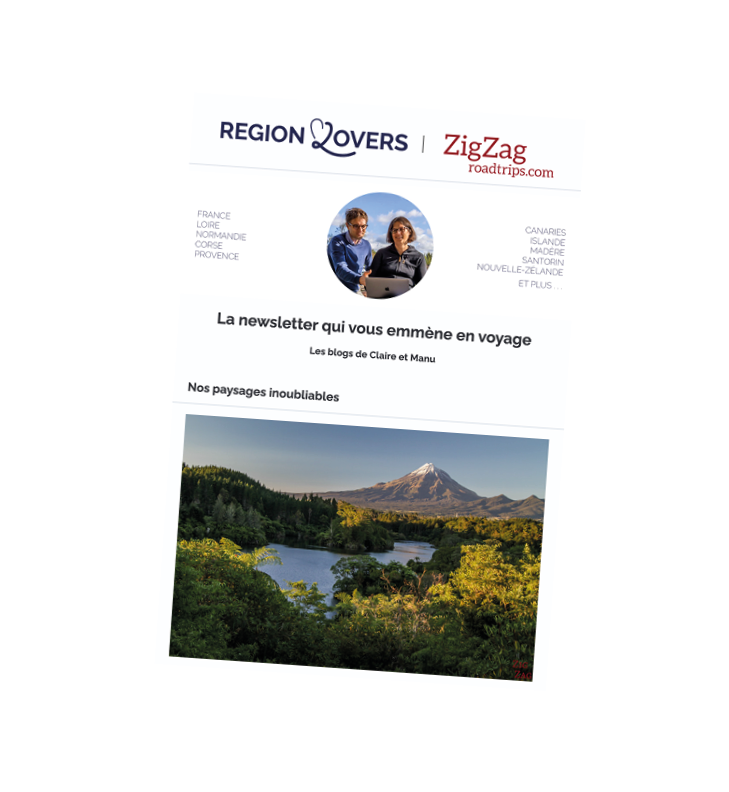
4. Juno Beach
The landing at juno beach beach – facts and figures.
Juno Beach was the landing site for the Canadian Army. It covered the section between La Rivière and Saint Aubin-sur-Mer, with the Love, Mike and Nan sub-sectors. The section is 6 miles long (about 10 km). 21,400 Canadian and British troops landed here. Casualties amounted to 1,200 wounded or killed (including 359 Canadian dead).

To reach the beach, you have to climb a small dune of white sand. The beach extends as far as the eye can see, when it is low tide.

The Cross of Lorraine is clearly visible. It was installed here to commemorate the place where De Gaulle first landed, an important turning point in the Battle of Normandy.

On the beach, not far from the museum, you can also see bunkers, tanks and representations of soldiers.

Museums in Courseulles-sur-Mer
- The Juno Beach Centre which focuses on the role played by Canadians alongside the Allied forces. You will discover a film and 5 permanent exhibition rooms. Closed in January Read more
- Beny-sur-mer Canadia War Cemetery : not far away you can visit the Canadian cemetery where over 2000 men are buried. Accessible all year round

Juno Beach Beach is surrounded by a very nice resort. It is a good base for a stay in Normandy. The museum is on the beach. And the cemetery is only 10 minutes away. You should plan for a half to a full day. We stayed at the hotel Ferme de la Rançonnière: stones and beams, everything that makes the charm of a Norman farm. See photos, prices and availability Otherwise, there are hotels in Courseulles – see the top rated hotels around Juno Beach
5. Sword Beach
The landing at sword beach beach – facts and figures.
The Sword Beach Beach landing was one of the most strategic because it was one of the main routes to northern France. It covered the section between Saint-Aubin-sur-Mer and Ouistreham, with the Oboe, Peter, Queen and Roger sub-sectors. The section is 5 miles long (about 8 km). 29,000 British troops landed here. Casualties amounted to 630 killed and wounded.

On the beach of Ouistreham, few traces of the war. It is a very large sandy beach with beach huts. On the other hand, the city is rich in museums.

Museums in Ouistreham
- Atlantic Wall Museum – The Great Bunker : Explore the former German headquarters in this massive bunker. The interior rooms have been reconstructed on all 5 levels. Closed in January and early February
- Pegasus Memorial : museum that presents the different missions of the 6th British Airborne Division, including the capture of the bridge of Bénouville called Pegasus Bridge. Closed from December 16 to January 31
- Museum No. 4 Commando : the history of French commando who joined the British troops and participate in their missions Open from April to early November
- Merville Battery: a German battery transformed into a museum with an excellent museography around bunkers, tanks, planes… Open from mid-March to mid-November
- Radar 1944 Museum (in Douvres-la-Délivrande): installed in the former German detection station, the museum presents the life of German soldiers during the occupation of Normandy as well as the history of radar. Open from April to mid-November
- And several cemeteries : La Délivrande, Hermanville, Ranville
Find out more about activities around Sword Beach .

Sword Beach Beach is in Ousitreham, a seaside resort with a huge beach. The museums are close to the beach. The Merville battery is 20 minutes away. Douvres-la-Délivrande is 20 minutes away. You should plan at least one day but 2 days will allow you to cover more places. There are many hotels and rentals in Ouistreham – see the top rated hotels around Sword Beach
Normandy beaches – D-Day in numbers
Just over 156,000 men landed on the beaches of Normandy.
The allied troops arrived
- Paratroopers: over 23,000
- By sea: over 133,000
The soldiers disembarked by nationalities
- Americans: approximately 73,000
- British: approximately 62,000
- Canadian: approximately 21,000
- and also soldiers from Belgium, Norway, Poland, Luxembourg, Greece, Czechoslovakia, New Zealand and Australia.
- And more than 170 French commandos
Casualty estimates – how many died on the beaches of Normandy
- Number of allied losses on June 6 at midnight (killed, wounded, prisoners…): more than 10 000
- Number of German losses on June 6 at midnight (killed, wounded, prisoners…): estimated between 4000 and 10000…

The equipment
- Support aircraft: over 11,000
- Combat ships: more than 1200
- Landing ships; over 4,000
- Merchant ships: over 800
- The ships were 80% British and 16% American
Frequently asked questions about beaches
Landing beach in 1 day.
If you only have one day to visit the D-Day landing beaches, it is best to choose one of the 5 beaches described in this article according to your interests:
- Omaha is the most emblematic of the beaches with the sculpture and the American cemetery
- Utah or Omaha for the Americans
- Juno for Canadians
- Gold Beach for the British
- Gold Beach for those interested in temporary port engineering
- Sword Beach and Utah Beach for the best museums (in our opinion)
What was the bloodiest beach on D-Day?
The losses on Omaha Beach were the worst on D-Day. American troops lost more than 2400 soldiers who were killed, wounded or taken prisoner.
Are the beaches of Normandy still stained with blood?
No. Without the memorials, bunkers and cemeteries, it is impossible to imagine what happened on these beaches in 1944. These are now beautiful sandy beaches where people swim in the summer.

Can we take sand from the beaches of Normandy?
No. As in many other countries, it is illegal to take sand or pebbles from French beaches.
Visit the D-Day landing beaches in winter
You can visit the D-Day landing beaches in winter. The winter atmosphere is more conducive to introspection on their history than the summer crowds… Please note, however, that almost all museums close at least in January and early February. Closing times depend on the museum. See our article on museums . However, the beaches and many of the bunkers remain freely accessible.
Films on the D-Day beaches in Normandy
The Longest Day (1962) A very realistic account of the landing at Omaha Beach. Take a look at it before your visit, to better contextualize everything you are about to see.
Saving Private Ryan (1998) War movie directed by Steven Spielberg with Tom Hanks and Matt Damon. It is inspired by the real-life story of the Niland brothers, American soldiers killed during World War II. In this fiction, the hero goes in search of the last survivor to bring him back to his mother.
Overlord (1975) Black and white film by Stuart Cooper. Story of a young recruit and his training before D-Day.
PLAN YOUR TRIP TO Normandy
Inspiration destinations
- Deciding where to go in Normandy – the best destinations
- Our weekend ideas: best-of , romantic , unusual , seaside , luxury , family
- 16 seaside hotels in Normandy
- The most beautiful charming hotels in Normandy

- Best things to do in Normandy
- Best cities in Normandy
- Most beautiful beaches of Normandy
- Most beautiful villages of Normandy
- Best castles of Normandy
- Best abbeys of Normandy
- Read our complete guide to visit the Mont-Saint-Michel
- Discover the D-Day sites

- Where to stay in Normandy – best places and hotels
- See our tips for renting a car at CDG airport , Orly airport , Beauvais airport , Caen , Rouen , Bayeux …


SHE MADE THE TRIP AND WROTE THE ARTICLE Claire
Region lovers' 10 commitments.
- Visit all the places we tell you about.
- For each city, stay in at least one hotel and visit the ones we recommend.
- For each city, eat in at least one restaurant, visit the ones we select.
- Pay all our invoices in full, refuse any partnership or sponsorship.
- Periodically update our articles, with the help of our readers.
- Enrich our articles with our first-hand experiences.
- Use 99% of our own photos
- Use digital tools in a reasoned and transparent way, feeding them with information verified on site.
- Provide information on the traveler/writer pairing that gave rise to the article.
- Tell you what we do, and do what we tell you!
Claire and Manu
Find out more about the team and our history.

SEARCH OUR SITE
Our multi-destination blogs.
Regionlovers.fr
ZigZagroadtrips.com
OUR OTHER REGIONS TO DISCOVER
LoireLovers.fr
CorsicaLovers.fr
ProvenceLovers.fr
CanariasLovers.com
CHANGE LANGUAGE
Legal Notice / Terms of Use / Privacy Policy

Why Normandy Still Matters: Seventy-Five Years On, Operation Overlord Inspires, Instructs, and Invites Us to Be Better Joint Warfighters
By Bryon Greenwald Joint Force Quarterly 95
Download PDF
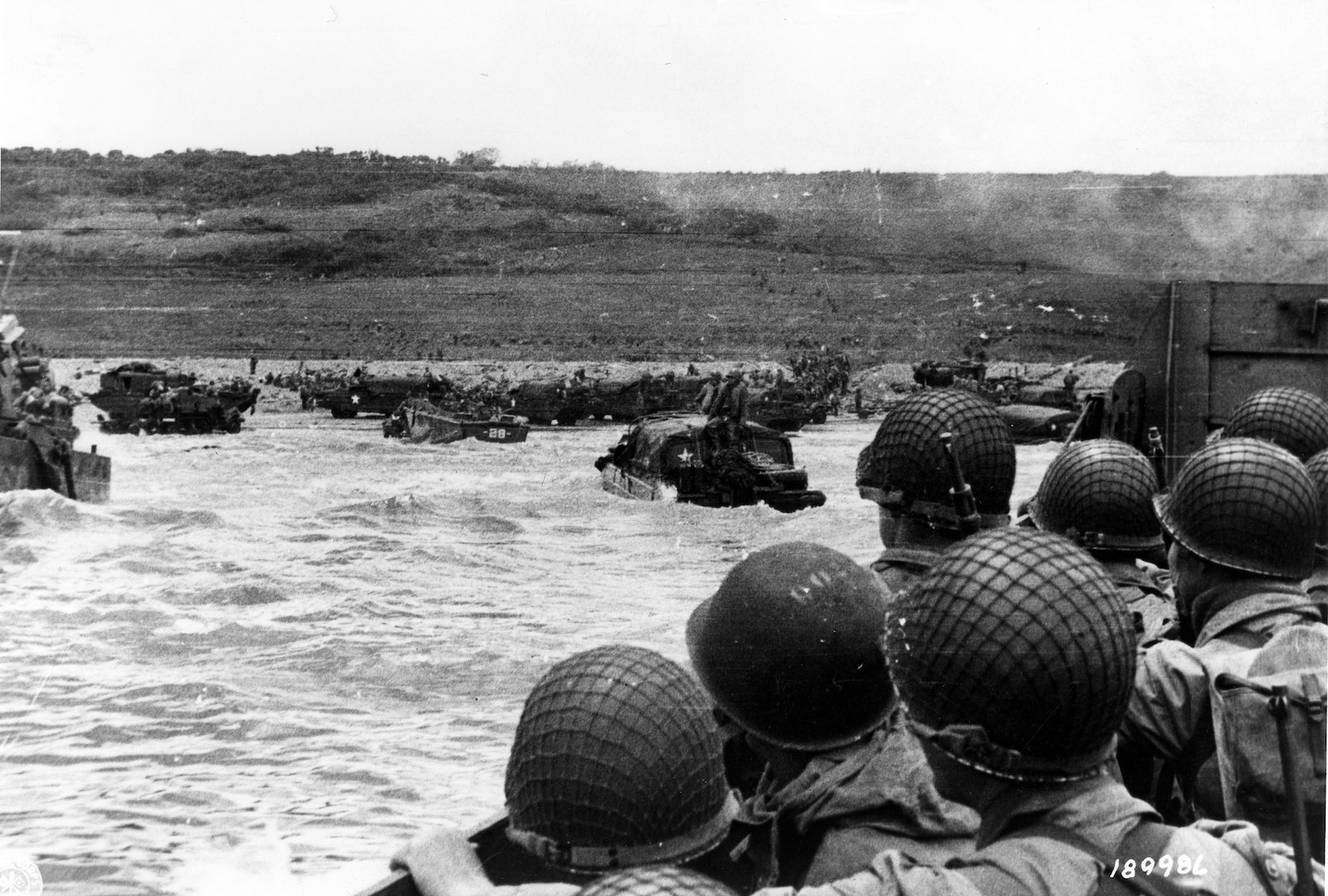
T he 50-mile stretch of French coastline running from midway up the Cotentin Peninsula east to the Orne River is hallowed ground for all who cherish democracy and the rule of law and the freedom and economic prosperity those values permit. There, on June 6, 1944, Allied forces conducted an enormous amphibious invasion across five beaches—Utah, Omaha, Gold, Juno, and Sword—that caught the Germans by surprise and initiated the end of Nazi reign over Europe. The invasion not only enabled American, British, Canadian, French, and other forces to join the Russians in defeating Germany, but it also allowed them to advance far enough east to prevent Soviet suzerainty over most of Western Europe after the war. In its success, Operation Overlord ushered in an open, democratically based economic system that has since expanded beyond its meager beginnings and improved the lives of hundreds of millions of Europeans.
This article celebrates the success and sacrifice of Operation Overlord on its 75 th anniversary, acknowledges both the achievements and mistakes made in planning and execution, and asks readers to compare the abilities of the current joint force with those of World War II. Geared to those who are familiar with, but not expert in, the critical components of the operation, this article reviews key aspects of the invasion and offers insight into the difficulty of orchestrating such a complicated joint and multinational endeavor at a time when radio communications were in their analog infancy. The article also provides teaching points for emerging military strategists and planners and critiques the operation. Finally, the article asks the reader to question whether today’s joint force could achieve something similar, not in size or scale, but sophistication, even with the benefit of global digital command and control suites.
As anniversaries go, the 75 th anniversary of Operation Overlord holds special significance. As with all the major battles of World War II, it will certainly be one of the last major anniversaries where any of the participants are still living. 1 As such, their sacrifice in that mighty endeavor should not go unnoticed. And although it occurred almost a lifetime ago, the Allied effort to plan and execute the invasion still provides an extraordinary opportunity to examine the difficulty of planning and conducting integrated, all-domain, and joint and combined forced-entry operations against a lethal enemy whose antiaccess/area-denial preparations were immense—something that today’s joint force is just now reexamining after spending nearly a generation in counterinsurgency operations. Finally, as Russia and China continue to act aggressively on the world stage, this anniversary may turn out to be one of the last to occur during the relatively peaceful interregnum in Great Power competition the world has enjoyed since the end of the Cold War. Thus, 75 years after airborne troops leapt into the dark French night and thousands of aircraft and hundreds of warships protected dog-faced soldiers as they spilled from plywood landing craft on to fire-swept beaches, the efforts of our forefathers to plan and conduct Operation Overlord should inspire us, instruct us, and invite us, as a joint force, to improve our ability to plan and execute all-domain operations.
An Inspiration for All
The invasion of Normandy inspires us by its sheer audacity, its enormous size and scale, and, of course, the personal courage of those involved. To describe the invasion as audacious, however, understates the precarious, one-shot, roll-of-the-dice nature of the event. At the tactical level, the Allies prepared for the attack almost within eyesight of German forces. At their closest points, Britain and the European coast are a mere 20 miles apart. Many of the 120 German radar sets clustered from Calais to Guernsey could easily spot ships and aircraft moving in the English Channel. 2 Portsmouth and Southampton, two of the main ports from which British forces would sail, are only 100 miles from Normandy. In today’s strategic environment, that would be the same as launching an invasion from an intermediate staging base like Taiwan toward mainland China or from Kaliningrad to Sweden.
At the operational level, the Germans expected the attack, but could not pinpoint exactly where or when it might occur. Many suspected the Allies would attack across to the Pas-de-Calais, continue through the German industrial base in the Ruhr, and on to Berlin. This avenue offered the most direct route and gave Allied aircraft the greatest amount of loiter time over the invasion area, but it also meant capturing a heavily defended port and fighting through the majority of German forces, including Panzer divisions, in the west. Some senior German leaders, however, suspected that the attack might come elsewhere. The failed Anglo-Canadian attempt to attack the heavily defended port at Dieppe in August 1942 proved just how difficult that approach would be in the future and hinted at an over-the-beach invasion.
Generalfeldmarschall Erwin Rommel, in charge of all western defenses from the Bay of Biscay to Denmark, initially leaned toward Calais, but considered a Normandy invasion likely. He focused his attention on what the Allies would call Omaha Beach because its long concave waterfront resembled Salerno, which the Allies had assaulted in September 1943. Even Adolf Hitler had a premonition of an attack in Normandy, but hedged his bet by predicting the Allies would invade in both places. 3 Fortunately, in doing so he unwittingly supported the Allied deception plan designed to make the attack on Calais appear as the operational main effort.
Finally, the assault was strategically audacious. Other amphibious assaults during the war were no less daring, difficult, or deadly, but they were essentially “away games” for both sides, fought by the Allies against second-tier or lesser forces that were unprepared, undersupplied, isolated, or retreating. With Operation Torch in North Africa, the Allies conducted an error-filled assault on Vichy French forces in a secondary theater and later defeated Rommel’s beleaguered army in Tunisia. 4 In Operation Husky , the successful yet flawed amphibious landing on Sicily, the Allies learned the difficulty of transitioning from ship to shore and air to ground against a wounded but deadly enemy. 5 Even in the Pacific, as ferocious as the fighting from Tarawa to Okinawa was, the Americans isolated the Japanese, cut their air and naval support, and pounded them relentlessly with naval gunfire, artillery, and aviation. 6 Victory in those battles was bloody, but never in doubt. Moreover, while all those amphibious assaults carried tactical and operational risks, their outcome was not in question, and beyond North Africa, even their failure could not derail Allied strategy.
The invasion of Normandy, however, was fought on German ground, although their lease on French territory was only 4 years old. And while Hitler’s boasts of Festung Europa (Fortress Europe) and the impenetrable Atlantic Wall were largely just that, once he placed Rommel in charge in early 1944, the defenses improved dramatically. With characteristic energy, Rommel revitalized languid units and layered the coast with hundreds of pillboxes and tank traps, thousands of obstacles, and millions of mines, many deviously placed to be underwater at high tide. 7 And unlike in other amphibious assaults, the Germans could reinforce the assault area with Panzer and other units from as near as the Pas-de-Calais and as far away as the Eastern Front.
Beyond all of these tactical and operational factors, Normandy posed the likelihood of strategic and political failure. If Rommel had succeeded in throwing the Allies back into the Channel, the chance of a follow-on Allied attack within a year or two was extremely remote. While General George Patton’s Third Army was sitting in England in reserve, it would take time to reconstitute losses in landing craft. Besides, not only was Prime Minister Winston Churchill already antsy and given to visions of a repeat of Gallipoli, the Somme, and Passchendaele, with Allied blood filling the Channel, but the British were also running out of men and had started cannibalizing divisions for infantry replacements even before the invasion started. 8 There was simply no more ink in the British well to spill on a second attempt. Operation Overlord was their only opportunity.
Exacerbating an initial defeat in France, any Allied pause to regroup would have allowed Hitler to expand his V-weapons campaign, which was already ravaging London. The combination of the two might have caused Churchill’s government to fall and resulted in a negotiated peace. Finally, an Allied defeat in Normandy would have freed the majority of German units to turn back to the east, where they might battle Russia to a stalemate and possibly a negotiated peace as well. Overlord really was a one-shot effort.
Despite a shortage of British manpower and barely enough transport to conduct the invasion, the size and scale of the operation was breathtaking. Today’s strategists and operational planners can only begin to fathom the magnitude of the combined force and complexity involved in marshalling, moving, and synchronizing its effects in a world where analog communication was difficult and digital technology nonexistent. Crammed into England at over 2,000 camps and airfields were over 1.5 million American and 600,000 British servicemen organized into 20 U.S. and 16 British, Canadian, and Polish divisions as well as scores of other ground, sea, and air forces. Another 37 U.S. divisions were to follow, either through England or directly from America. 9 The initial invasion launched five divisions destined for four nearly contiguous beaches running east to west—Sword, Juno, Gold, and Omaha—and one outlier on the Contentin Peninsula closer to the port of Cherbourg near Utah Beach. Three other divisions followed in trail.
Transporting these forces across the Channel from 171 British ports at night under radio silence were nearly 7,000 vessels operated by almost 200,000 sailors, coastguardsmen, and merchantmen in Operation Neptune , a supporting operation to Overlord that focused on the crossing and beach landings. This armada included 138 destroyers, cruisers, and battleships. These warships provided this fleet’s seapower, but the landpower needed to retake Europe arrived on 46 different types of landing craft, approximately 4,200 in all, including the critically short landing ship tank or “long slow target” capable of carrying half an armor battalion and depositing it on the beach via its massive bow doors. 10 This enormous and diverse force rendezvoused about 13 miles south of the Isle of Wight, in Area Z, or as it was called “Piccadilly Circus,” and led by 300-odd minesweepers, chopped across the Channel in 5 and then 10 lanes averaging about 800 yards wide in search of the midget submarines that marked the boundaries of the invasion area. Ahead of these forces, two U.S. and one British airborne division, 23,400 troops in all, dropped at night to secure key points behind Utah Beach and seal the eastern flank along the Orne River from counterattack. Moving these men were almost 1,400 transports and over 760 gliders (416 with U.S. forces and at least 250 with British). Blasting the far shore and sweeping the skies over this force were nearly 4,500 bombers and 4,000 fighters. By sunset at 10:06 p.m. local time, the Allies had placed over 155,000 men, 1,550 tanks, and 12,500 vehicles ashore. 11
Beyond its size and scope, what one soldier in the German 716 th Static Infantry Division described as a “gigantic city at sea,” the force contained several specialty vehicles that spoke to the value of innovation and organized industrial strength. 12 Operating with the invasion force were Duplex Drive tanks that could swim ashore albeit under the right conditions; Crocodiles, tanks turned into tracked flamethrowers; Crabs, flail tanks fitted with heavy chains on a rotating cylinder that cleared minefields; Bobbins, tanks that rolled out a reinforced canvas road to drive on as they moved forward; Armored Ramp Carriers (ARKs), tanks that carried deployable ramps instead of turrets; and Ducks (DUKWs), 6-wheeled amphibious vehicles for moving men, 105-mm howitzers, and supplies ashore. 13 Finally, chugging along just behind the force were a flotilla of tugs hauling three miracles of modern industry—two artificial floating harbors and a pipeline under the ocean (PLUTO).
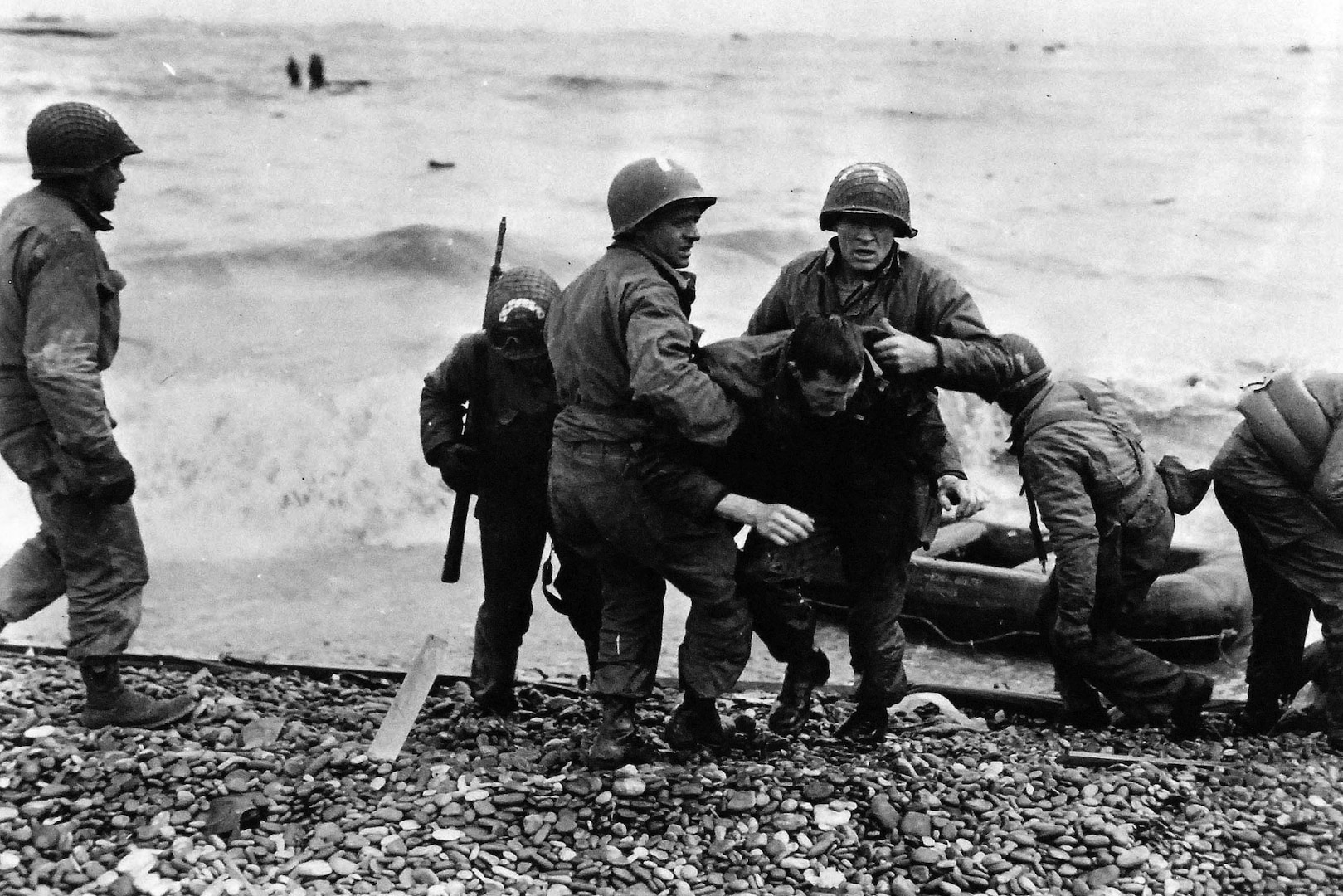
Given the difficulty expected in seizing a heavily defended deep-water port intact, the Allies, largely through British initiative, decided to bring two enormous ports with them. While logisticians intended to protect all five invasion beaches with “gooseberries” or artificial breakwaters, two beaches—Omaha and Gold—would serve as sites for the Allies two artificial floating harbors, codenamed Mulberries. Consisting of several unique elements, including floating steel pier heads and roadways and massive hollow concrete breakwaters for the inner harbor, these structures consumed about 661,000 U.S. tons of concrete and 100,000 U.S. tons of steel and took 45,000 men 8 months to construct. Although a tremendous storm (June 19–22) destroyed the American Mulberry at Omaha, the British port at Gold Beach survived and proved useful throughout the Normandy campaign. 14 Lastly, if 19 th -century armies marched on their stomachs, modern armies motored forward on petroleum. To keep their highly motorized and mechanized armies moving, the Allies developed and laid hundreds of miles of steel PLUTO. Unfortunately, while engineering marvels, these pipelines suffered from accidents with ships’ anchors and breakage that limited their timely transport of fuel. This shortfall led to an early adaptation of existing transport capacity, the Red Ball Express, as supply officers commandeered 7,000 2.5-ton trucks to transport 4,000 tons of fuel, mostly in 5-gallon jerricans, on one-way highways to supply points in the First and Third U.S. Army areas. 15
Notwithstanding the countless acts of bravery noted over the last generation of conflict in Afghanistan and Iraq, the personal courage demonstrated during Operation Overlord by men at all levels still inspires and serves as an example to us all. From Supreme Allied Commander General Dwight D. Eisenhower through component commanders and senior leaders, to the engineers, Seabees, medics, and infantrymen that first landed in Normandy, their actions and level of personal responsibility represent our better selves even in the darkest of times.
Consider Eisenhower’s example of humble strategic leadership. At 4:30 a.m. on June 4, he postponed the invasion for 24 hours due to extremely bad weather, knowing that there were only 4 days—the 5 th , 6 th , 19 th , and 20 th —in June that provided the right combination of a late rising moon and early morning rising tide to create the opportunity for a successful assault. Seventeen hours later, as wind and rain lashed the windows of his temporary headquarters at Southwick House near Portsmouth, Eisenhower received a forecast update indicating a mild break in the weather for June 5 and 6. After polling his commanders, he calmly assessed the situation, wondering aloud, “How long can you hang this operation on the end of a limb?” He committed to launch the assault with a final go/no-go weather update at 4:15 a.m. on June 5. At that meeting, after receiving confirmation that the weather break would hold, he announced without any pomp, “Okay, we’ll go.” He then returned to his private trailer where he handwrote a note taking complete and personal responsibility for the invasion if it failed and stuffed it in his wallet. Finally, he visited Greenham Common airfield to meet paratroopers from the 101 st Airborne Division, staying to watch the last of their aircraft take off, saluting with tears in his eyes and knowing that by dawn many of those he met would be dead. 16
Then there was the calmness and clarity of men under fire, men like Rear Admiral John Leslie “Jimmy” Hall, Jr. Known in modern joint parlance as the Commander, Amphibious Task Force, Hall directed the assault on Omaha Beach from the USS Ancon. In the midst of the assault, he cautioned a very anxious Major General Clarence Huebner, Commander of the 1 st Infantry Division, to be patient and let the stalemated situation on Omaha develop further, thereby preventing Huebner or First Army Commander General Omar Bradley from issuing what would have been a disastrous order to evacuate the beach. 17 Another example is Brigadier General Theodore Roosevelt, Jr., the Assistant Commander of the 4 th Infantry Division, who landed 2,000 yards off course with the first wave at Utah Beach and calmly decided that “we’ll start the war from here.” 18 Brigadier General Norman “Dutch” Cota, Assistant Division Commander of the 29 th Infantry Division, on landing in the second wave at Omaha Beach, found the men leaderless and not moving. Walking westward under fire, he admonished troops to “get off the beaches,” encouraged the “Rangers to lead the way,” and then, after machine gun fire had stalled an attack, personally led a charge through a gap in the wire and up the bluff east of Vierville-sur-Mer that enabled men from the 116 th Regimental Combat Team (RCT) to outflank German defensive positions at the D-1 (Vierville) draw. Regimental commanders like Colonels Charles Canham (116 th RCT) and George Taylor (16 th RCT) similarly led from the front and exhorted men to advance. 19
The Rangers scaled the 100-foot cliffs of Pointe du Hoc while dodging German grenades and rifle fire, and lieutenants, sergeants, and privates led platoons, squads, and confused groups of men forward—always forward. Finally, any of the thousands of frightened men who, scrambling to exit their Higgins boats, “tumbled out just like corn cobs off a conveyor belt” and were hit by fire from German machine gun nests covering “Bloody Omaha.” 20 One only has to read the names on the 29 th Infantry Division and Engineer Special Brigade monuments or walk up the slopes behind Omaha Beach about 500 yards to a great granite obelisk engraved with the names of the 627 men from the 1 st Infantry Division who died that day, including 3 names etched in gold signifying that they won the Medal of Honor, to realize that uncommon valor was a common occurrence on June 6, 1944.

Instruction for Today
Despite the passage of time, Operation Overlord continues to offer valuable lessons across a range of critical topics. Chief among these lessons is the importance of getting the overarching war policy correct through coherent and clear-eyed national security policy planning. To paraphrase Carl von Clausewitz, senior leaders should avoid turning the purpose of war into something alien to its nature—a mistake many contend the United States made in Iraq. Other lessons include the need to align strategic goals with higher policy ends, the criticality of determining and sequencing of essential tasks, and the value of developing an operational approach to achieve strategic and operational objectives and then planning in reverse from the point of success to ensure forces and actions are arranged, sequenced, and supported appropriately in time and space.
Lessons on Policy Planning and Strategic Alignment. Against the backdrop of the Vietnam War and the wars in Afghanistan and Iraq, Operation Overlord stands as an example of what coherent policy, grand and theater strategy, all-domain operational design, and organizational acumen can achieve. At the level of Allied policy, in late summer 1940, with Germany having conquered most of Western Europe and now bombing and preparing to invade Great Britain, U.S. Army and Navy leadership shrugged off decades of planning for a potential war with Japan and came to the conclusion that the survival of Great Britain and its Empire was in the best interest of the United States. As the now historic memorandum sent by Chief of Naval Operations Admiral Harold Stark to President Franklin D. Roosevelt in November 1940 stated, “If Britain wins decisively against Germany, we could win everywhere; but . . . if she loses the problem confronting us would be very great; and while we might not lose everywhere , we might, possibly, not win anywhere .” 21 Thus, despite planning for a war with Japan since 1907, the national security apparatus recognized the greater threat and adjusted its overarching policy accordingly. That the Nation would remain committed to this policy after the Japanese attack on Pearl Harbor speaks to the quality of analysis and the strength of its conclusion.
This tectonic shift in policy quickly led the United States and Britain to expand senior military staff talks on global strategy and resulted in a series of Allied decisions over the next few years that framed the overall strategic direction for the rest of the war. As they applied to Normandy, these decisions were to avoid negotiated settlements and seek the complete defeat of the Axis nations; defeat “Germany First”; invade North Africa in 1942 instead of attempting a cross-channel attack; resource the Combined Bomber Offensive to attack German forces, resources, and cities; and invade Northwest Europe in 1944. 22 All these decisions demonstrate to contemporary officials, as Clausewitz notes, the importance of understanding the political purpose of war and the need to work hard to get the policy and strategy aligned as correctly as possible. For as the Germans learned, no amount of operational or tactical virtuosity can rescue a military force from bankrupt strategic direction. 23
Lessons on Determining and Sequencing Essential Tasks. Before tackling any of its strategic objectives, however, the United States had to complete a series of essential tasks. It needed to raise, organize, train, and equip the military forces of all four Services (Army, Army Air Forces, Marines, and Navy) to a level where they could fight and sustain a series of global campaigns for years. 24 Before contemplating an attack on Europe, the Americans needed to sustain the British, who were rebuilding their own military after Dunkirk and suffering a 60 percent decrease in foodstuffs and fuel due to the success of the German U-boat campaign against commercial shipping in the Atlantic. 25 Thus, American and British forces needed to win the Battle of the Atlantic before they could ever reasonably consider beginning the necessary logistical buildup to support an invasion of the continent. Finally, the Allies had to win control of the air to allow any invasion force a modicum of freedom of maneuver.
In 1942, Army Chief of Staff General George C. Marshall and his Chief of War Plans, Brigadier General Dwight D. Eisenhower, pressed for a direct attack on the Germans as soon as possible, and certainly not later than 1943. Thus, prior to the decision to invade Normandy, the most instructive decision from both a geopolitical and strategic perspective was Roosevelt’s July 1942 decision to invade North Africa, which he made against the wishes of his military advisers. Hailed by some today as an example of the value and need for civilian control of the military, the decision makes complete sense in hindsight. Roosevelt wanted American troops in combat against the Germans in 1942, but neither the British nor the American militaries were ready to conduct a contested amphibious landing against the Germans on the coast of France. 26 The British, who had already lost several battles to the Germans and who at that point would have to provide the majority of forces, were accordingly reluctant. And as the clumsiness of American operations in North Africa indicated, U.S. troops and their leaders were simply not ready to take on German forces in an amphibious assault. 27 Even Marshall later intimated that the idea of landing 25 divisions in Europe in 1942 might have been “suicidal.” 28 Moreover, as much as General Eisenhower lamented about “wasting resources all over the world,” the fact remained that shipping and amphibious craft, two important resources for globally integrated operations, were in short supply—so much so that in 1944, Eisenhower, as Supreme Allied Commander, requested a 1-month delay in launching Operation Overlord in order to obtain more “long slow targets.” 29
Eventually, the Americans and British overcame their collective difficulties in North Africa and began to prepare for an invasion of Europe. In February 1943, they formed an integrated planning headquarters under the Chief of Staff to the Supreme Allied Commander (COSSAC), British Army Lieutenant General Frederick Morgan, and selected Normandy as the site of the invasion. In May 1943, as American and British soldiers defeated the Germans near Tunis and captured 275,000 soldiers, their leaders met in Washington, DC, at the Trident Conference and set the date for Operation Overlord as May 1944. In the meantime, they would attack through Sicily and on to Italy with the goal of knocking Italy out of the war and forcing the Germans to send reinforcements to stop the Allies. This decision meant the Allies, in a supporting effort to the overall campaign in Europe, would fight a determined German enemy up the mountainous Italian boot on something of a shoestring as the British and Americans withdrew units and diverted supplies to begin the buildup for the invasion of France. 30
Lessons on Operational Design and Arranging and Sequencing Forces in Space and Time. Although not without issues, the quality of the operational design and joint/combined planning for Operation Overlord offers today’s leaders and planners an excellent example of integrated all-domain operations. 31 As for operational art and design, Allied planners developed an operational approach that envisioned the arrangement of real and fake forces in England such that the Germans viewed the area near Calais as the main objective and reinforced it accordingly with the bulk of their Panzer units. If successful, this action would give the Allies a better chance to get ashore as a coherent fighting force; to defeat a smaller, less powerful German reaction force; and to win the race to build up more combat power than the Germans could bring to bear in the assault area. Then beginning with the strategic guidance to “enter the continent of Europe and . . . undertake operations aimed at the heart of Germany and the destruction of her Armed Forces,” the COSSAC staff developed a concept of operations that integrated the multifaceted deception story with a three-division assault between the Orne and Vire rivers. In late 1943 and early 1944, Eisenhower and his ground commander, British General Bernard L. Montgomery, assessed the plan and found the force too weak. They drove further refinement and expanded it from three to five divisions, increased the airborne forces from less than one division to three, and added Utah Beach as an objective in order to facilitate capturing the vital port of Cherbourg. 32
Appropriately, the staff identified the key component of the German defense in the west as the Panzer divisions and corps. Known in today’s doctrine as the operational center of gravity, the Panzers were the only force with enough mobility and power to threaten the Allied landings; they were the glue that held the German defense together. The foot-mobile infantry had neither the speed nor the punch to stop the Allies, and the Luftwaffe could not provide significant air support because it was defending the skies over Germany from the Combined Bomber Offensive. To protect the landing sites from armored counterattack, the planners used a combination of information, intelligence, joint fires, and maneuver to fix Panzer units near Calais and impede the movement of other Panzer units into the assault area. 33
First, they reinforced the Fortitude South deception plan by deploying live units to mix with fake ones in eastern England and Scotland and broadcast scripted radio traffic to support the cover plan and augment the action of those units. 34 Second, planners assigned electronic warfare assets, ships, and bombers to execute tactical deception plans (Operations Taxable and Glimmer ) on the night of June 5–6 to trick German radar operators, shore lookouts, and intelligence personnel into believing the Allies were attacking north and east of Le Havre. 35 Third, using Ultra decrypts, overhead imagery, agent reports, and radio intercepts they identified the general locations of several Panzer units and targeted them for bombing, both before and after the assault. 36
Fourth, as part of the Transportation Plan, the Allies used bombers as part of their operational fires to drop the bridges over the Seine and the Loire rivers, essentially carving out a section of France and isolating it from German units to the east and south of the rivers. Fifth, they used air interdiction to destroy railheads and marshalling yards across France to force Panzer units on to roads, where they would consume precious fuel and could be hit by air or subject to sabotage by the French Resistance . In all these air attacks, the British and American air forces were careful to spread out their attacks, striking twice as many targets outside the Seine/Loire area as in it, to mask their intent to land in Normandy. Sixth, to create a tactical deception and assist inbound airborne forces, planners in Operation Titanic dropped special operations forces with amplifiers and recorded combat noise, thousands of rifle and machine gun simulators, and 200 dummy half-sized paratrooper “dolls” or, as the Germans called them, Explosivpuppen , in key areas throughout Normandy to confuse the Germans and draw off anti-paratrooper reaction forces. 37
Finally, planners dropped the 6 th British Airborne Division to the east of the Orne River and Caen Canal to blow up bridges over the Dives River, destroy an artillery battery capable of hitting Sword Beach, and capture the bridges at B é nouville and Ranville, which they did with an amazing glider assault. 38 On the west end of the assault area, the 82 nd Airborne Division secured the key road junction at Sainte-M é re- È glise and two bridges over the Merderet River, while the 101 st Airborne Division captured critical elevated causeways and provided the 4 th Infantry Division with a way across the flooded lowlands and off of Utah Beach.

In the end, the combined effect of these actions did indeed delay and impede the movement of Panzer and other units. Even after the Normandy landing, Ultra decrypts confirmed that Hitler remained convinced the main attack was still to come in the area of Calais and would not release the Panzer units there until early August. Closer in, the destruction of the bridges over the Dives River and the defense at the bridge at Ranville forced the 21 st Panzer Division to endure countless air attacks while driving around Caen to attack British and Canadian units from the south instead of more directly from the east. Operation Titanic succeeded in dispersing elements of the first-rate 352 nd Infantry Division and delayed Task Force Meyer (915 th Infantry Regiment) from counterattacking forces struggling ashore at Omaha Beach. 39 Finally, the interdiction of bridges and railheads forced the 2 nd SS Panzer Division, Das Reich, located near Montaubon in Brittany, to travel north toward Normandy intermittently by rail and road. At great risk, the French Resistance blew up fuel dumps, sabotaged rolling rail stock, destroyed rail lines, and organized small ambushes. All told, the Das Reich division took 17 days to move the 350 miles from Montaubon to Normandy, a journey that should have taken just 3 days. 40
Not Everything Will Go According to Plan, Failures to Anticipate and Prepare Will Occur, and Mistakes Will Happen . Despite its ability to deceive, delay, and disrupt the Germans, the Allied assault was not a complete success. As darkness fell on Normandy, the Allies had achieved none of their D-Day objectives other than getting ashore. At Utah, the 4 th Infantry Division had yet to link up with the 82 nd or 101 st airborne divisions. At Omaha, the beachhead was barely a mile deep and the beach itself was a disaster. At Gold, the 50 th British Division after a tough fight had failed to take either Port-en-Bessin-Huppain or Bayeux or link up with the Americans at Omaha. At Juno, the 3 rd Canadian Division advanced farther than any other unit, but failed to secure the high ground near the Carpiquet airfield west of Caen. And finally, at Sword Beach, the British 3 rd Division failed to take Caen.
At the tactical level, the tail end of the storm that initially delayed the invasion and caused the Germans to believe that nothing would happen on June 6 made bombing by sight difficult and sailing in small craft treacherous. But beyond the weather, errors in judgment cost lives and wasted tactical efforts, particularly on hard-fought Omaha Beach. B-24 Liberator pilots forced to bomb using radar and flying perpendicular to Omaha feared hitting the approaching landing craft. As a result, the lead pilots held their fire for an additional 5 to 20 seconds and 450 bombers ended up dropping their 13,000 bombs harmlessly on crops and livestock miles behind the German defenders. At sea, 6,000 meters (more than 3 miles) off Omaha, Army lieutenants and Navy and Coast Guard ensigns discussed the sea state with its 4-foot chop. Some considered it too dangerous to launch their Duplex Drive swimming tanks and artillery-carrying DUKWs that far out. Others debated and made the fateful decision to launch anyway. In one case, 27 of 32 Duplex Drive tanks and most of the artillery foundered and sunk. A number of Soldiers drowned and the Americans lost a great deal of the firepower they needed to suppress the 35 German pillboxes, 8 huge bunkers, and 85 machine gun nests guarding Omaha Beach. 41
Exacerbating these tactical errors were organizational decisions made by First U.S. Army Commander General Bradley that limited the amount of naval gunfire support or specialized armored vehicles available to the troops on Omaha. In the spring, Army Chief Marshall sent Bradley one of the Army’s experts in amphibious warfare, Major General Charles Corlett, from the Pacific. Despite a wealth of advice, Bradley and Eisenhower displayed no interest in learning from Corlett, viewing efforts in the Pacific as “bush league.” Corlett warned Bradley that he did not have enough naval gunfire to support the landings properly or enough ammunition for the upcoming land battles, both of which were ultimately proven correct. Moreover, despite Montgomery’s encouragement, Bradley dismissed the value of flail and other types of tanks offered by the British—only to wish later that he had them at Omaha. 42
At the operational level, intelligence failures influenced events on D-Day and beyond. First, Allied intelligence completely missed or “lost” the location of the 352 nd Infantry Division, a first-rate unit initially thought to be near St. Lô, but which the Germans moved forward in May. On D-Day, it stretched from the Vire River to Arromanches, with at least two infantry battalions and a light artillery battalion bolstering the defense of elements of the second-rate static 716 th Infantry Division at Omaha Beach. Second, the Americans utterly misunderstood the nature of the bocage country that filled the Normandy region south of the immediate beach area. With thick, impenetrable Norman hedgerows and sunken ox-cart tracks bordering thousands of small farm fields, the area was superb defensive terrain that armor could not breach, traditional artillery could not hit, and infantrymen could not enter without coming under withering machine gun and mortar fire. 43 The terrain provided such a series of natural obstacles that a two- or three-man team could defeat a platoon, a platoon might defeat a company, and a company could slay a battalion. The Allies had over 1 million photographs of the Normandy area and hundreds of intelligence reports, including one from April 1944 by Bradley’s First Army that warned that fighting there “be given considerable study.” As Bradley later stated, “I couldn’t imagine the bocage until I saw it.” It was “the damnedest country I’ve ever seen.” 44 One battalion commander was more succinct, noting later that “we were rehearsed endlessly to attack the beaches, but not one day was given to the terrain behind the beaches.” 45 This failure to recognize and react to the potential difficulties posed by the bocage country cost the U.S. Army dearly as divisions were bled white fighting south to the St. Lô-P é riers Road, the jumping off point for the “breakout” on July 25.
On D-Day, U.S. forces suffered approximately 12,000 casualties, including 8,230 Americans. From D-Day until July 31, Bradley’s First U.S. Army took 100,000 casualties, including 9,939 in the 29 th Infantry Division and 7,876 in the 4 th Infantry Division, both of which fought through the bocage . Eighty-five percent of the casualties were infantrymen. 46
Finally, perhaps the greatest failure in planning and leadership was Montgomery’s inability to take Caen, his D-Day objective for the 3 rd British Infantry Division at Sword Beach. Montgomery and his army, corps, and division commanders failed to plan backward from their objective. They did not factor in likely confusion on the beach, consider the likely exhaustion and culmination of their initial and follow-on forces, anticipate German counterattacks by elements of the 21 st Panzer Division, and provide for additional forces to pass through and take Caen. While the Germans certainly had a role to play with their staunch defense at the Hillman strongpoint and along P é riers Ridge, it is clear that the 3 rd British Infantry Division faced too many tasks and suffered too many diversions that frittered away its combat power. 47 In essence, Montgomery, Lieutenant General Miles Dempsey, Lieutenant General John Crocker, and Major General T.G. Rennie ignored the timing and tempo of operations, did not mitigate known risks, and failed to arrange their forces such that they would have the staying power necessary to seize their admittedly ambitious objective in the face of likely opposition. 48 Despite relentless Allied air and r é sistant attacks, the Germans managed to reinforce the area with Panzer forces. In some of the largest tank battles of the war, Montgomery and Dempsey would spend the next 45 days attempting to envelop Caen and capture the key operational terrain on Hill 112 that opened the path to Paris and beyond. 49 Meanwhile, the Americans, due to their own failures to anticipate and prepare for fighting in the bocage, would slog forward, grinding through divisions and wearing down Germans forces until their own breakout in Operation Cobra on July 25.
The study of Operation Overlord teaches today’s commanders and planners that designing an all-domain operational approach that keeps the enemy off balance and synchronizes the integrated joint and combined actions of thousands of aircraft and ships and hundreds of thousands of men under the watchful eyes of the enemy is excruciatingly hard to do, let alone do well. It requires an uncommon level of operational understanding and joint knowledge. Overlord also warns us to expect that our adversaries may be both lucky and good, and as well-equipped and trained as we are. It cautions those conditioned by decades of all-domain dominance against less than first-tier opponents to expect that even the best plans will go awry and, unlike the Americans in the bocage, we should plan and train for that eventuality as well.
In the end, success in Operation Overlord was “a close run thing.” 50 It succeeded in part because of America’s overwhelming ability to build and deploy a vast array of ships, landing craft, aircraft, tanks, and artillery; in part because of the individual and collective courage of the Allied servicemembers who fought it on the ground, on the sea, and in the air; and in part because the operational design and combined planning for the invasion synchronized all aspects of Allied capability sufficiently enough to provide the slimmest of margins when it mattered most.
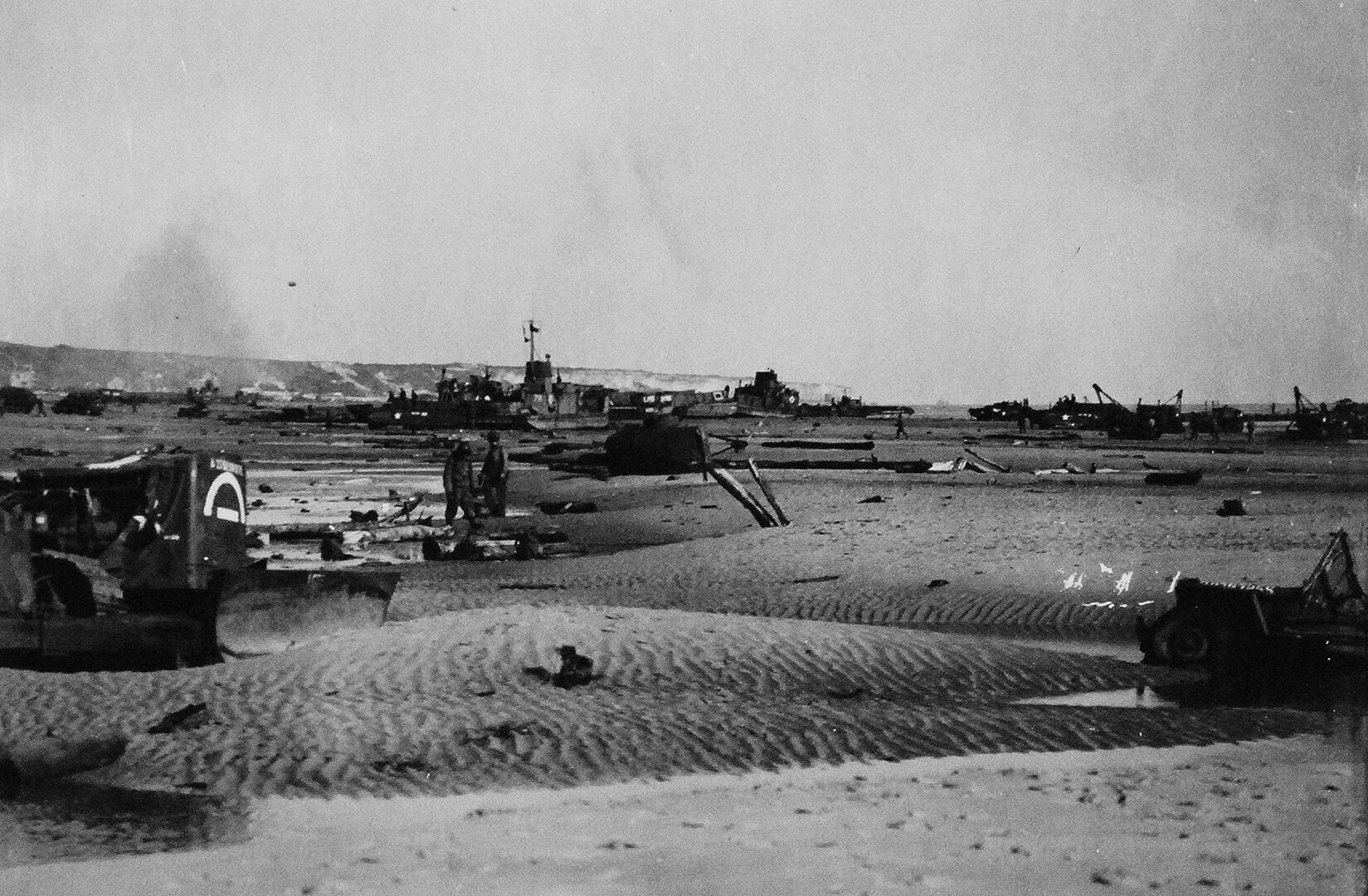
An Invitation to Improve
More than answers, Operation Overlord invites us to ask questions of ourselves and our ability to operate jointly. Specifically, could we do it again? Not in size, but in effect? Could the United States or NATO repeat an operation as complex as Overlord ? Are our generals and admirals, colonels and captains, and perhaps most important, the iron majors and commanders who sweat out the critical details, educated and savvy enough to conceptualize, organize, and synchronize an integrated joint/combined operation of Overlord -like complexity against a peer competitor?
Beyond our ability to conceive, plan, and synchronize such a complex event, the legacy of Operation Overlord invites us to consider if we are ready in unit manpower, equipment, and training readiness to execute combined operations of similar sophistication against Russia, China, or Iran as described in recent discussions of globally integrated operations. Is the Navy seaworthy? Can the Air Force get more than 60 percent of its aircraft airborne at any one time? Are the Army and Marine Corps robust enough to field full-up brigades and divisions without cutting late deploying units to the bone? Are we practiced enough in our Service-based skills that we can even attempt to integrate jointly?
For the joint force, this calls into question whether we can integrate seamlessly above Service level, on the fly, at night, under radio silence, without GPS, just as the forces did in approaching Normandy. Are we resilient enough to take a punch on the chin (like our forefathers did at Bataan, Kasserine Pass, or Anzio) and recover? Or are we too fragile—too unprepared intellectually, too thin in necessary force structure, or too technologically dependent—to win the battles, campaigns, and wars we portend with Great Power competition?
Finally, do we have the requisite mental and command flexibility, organizational diversity, and depth to recover from an adversary’s first bloody surprise moves and fight back to tactical, operational, and strategic positions of dominance? Do we have, as the Capstone Concept for Joint Operations 2030 asks, the “strength, agility, endurance, resilience, flexibility, and awareness” to recover and adapt? Today, are we in a joint “Boxer’s stance” ready to react, punch, and counterpunch, just as the men in Normandy did 75 years ago? Will we be a “globally integrated, partnered joint force that is designed and able to out-think, out-maneuver, and out-fight any adversary under conditions of disruptive change”? 51 Or will we be like the French in 1940, who had none of those qualities and subsequently lost so overwhelmingly that their first battle became their last?
In 1946, General Eisenhower and Chief of Naval Operations Admiral Chester Nimitz established the Armed Forces Staff College in Norfolk, Virginia, to capture and teach the joint lessons of World War II—lessons that the Army and Navy (as well as the Air Force and Marines) learned the hard way in the Pacific, North Africa, and Normandy, and sadly have relearned in numerous campaigns since then. Eisenhower later commented that “separate ground, sea and air warfare is gone forever. If ever again we should be involved in war, we will fight it in all elements, with all services, as one single concentrated effort.” 52 In the current era of Great Power competition that demands coherent policy and strategy and excellence in all-domain integrated operations, we can ill-afford to relearn the hard lessons that Eisenhower and Allied forces learned so expensively during Operation Overlord 75 years ago. We must not only continue to teach the joint lessons of World War II and other conflicts, but we must also improve our Service and joint readiness and prepare leaders from all Services to think, act, and behave jointly so that we can plan and execute the next Overlord with some anticipation of success. JFQ
1 Figures from the U.S. Department of Veterans Affairs displayed by the National World War II Museum indicate that of the 16 million World War II veterans, fewer than 400,000 are alive in 2019, down approximately 100,000 from 2018. Available at <www.nationalww2museum.org/war/wwii-veteran-statistics>.
2 Winston S. Churchill, The Second World War , vol. 6, Triumph and Tragedy (Boston: Houghton Mifflin, 1953), 10.
3 Antony Beevor, D-Day: The Battle for Normandy (New York: Viking, 2009), 34, 36.
4 See Rick Atkinson, An Army at Dawn: The War in North Africa, 1942–1943 (New York: Henry Holt, 2002).
5 See Carlo D’Este, Bitter Victory: The Battle for Sicily, 1943 (New York: Harper Perennial, 2008); Rick Atkinson, The Day of Battle: The War in Sicily and Italy, 1943–1944 (New York: Henry Holt, 2008). For a personal perspective of both Sicily and the airborne assault into Normandy, see James M. Gavin, On to Berlin (New York: Bantam Books, 1984).
6 See Williamson Murray and Allan R. Millett, A War to Be Won: Fighting the Second World War (Cambridge, MA: Belknap Press, 2001), chapters 9, 13, 17.
7 See Murray and Millett, A War to Be Won , 412; Beevor, D-Day , 36–37; and Carlo D’Este, Decision in Normandy: The Real Story of Montgomery and the Allied Campaign (New York: Penguin, 2004), 85, for similar opinions on German preparations.
8 Winston S. Churchill, The Second World War , vol. 5, Closing the Ring (Boston: Houghton Mifflin, 1951), 582–583, 710–711; D’Este, Decision in Normandy , 29–30, 252–270; and Rick Atkinson, The Guns at Last Light: The War in Northwest Europe, 1944 – 1945 (New York: Henry Holt, 2013), 15.
9 Atkinson, The Guns at Last Light , 18, 21. U.S. forces alone occupied 1,200 camps and 133 airfields.
10 The total force included 138 warships, 1,100 other combat ships, 4,200 landing craft, 221 escorts to protect the convoy, 805 cargo ships, and 59 obsolete craft to be used as breakwaters off of Omaha and Gold beaches. For example, a Landing Ship Tank could carry 20 Sherman tanks, 30 heavy trucks, 40 jeeps, and 350 men.
11 Figures and information compiled from Atkinson, The Guns at Last Light , 15, 36–37; Murray and Millett, A War to be Won , 420; Craig L. Symonds, Neptune: Allied Invasion of Europe and the D-Day Landings (New York: Oxford University Press, 2014), 225–226, 305; and Ken Ford and Steven J. Zaloga, Overlord: The D-Day Landings (New York: Osprey Publishing, 2009). For a detailed description of landing craft, see Symonds, Neptune , 146–170.
12 Beevor, D-Day , 92.
13 For more on Field Marshal Percy Hobart’s tank inventions, see Patrick Delaforce, Churchill’s Secret Weapons: The Story of Hobart’s Funnies (London: Robert Hale, 1998). For more on the DUKW, see the U.S. Army Transportation Museum, available at <www.transchool.eustis.army.mil/Museum/DUKW.htm>.
14 Debate exists as to the cost-benefit of the Mulberries. Craig Symonds contends that the Allies transported just as much over the open shore at Omaha after the storm wrecked the American Mulberry as the British did using the Mulberry at Gold Beach/Arromanches. See Symonds, Neptune , 319–328. The British Mulberry provided service until Christmas 1944 when workers began dismantling it. For a succinct history, see Alain Ferrand, Arromanches: A History of a Harbour (Bayeux, France: OREP Editions, 2007).
15 PLUTO and Red Ball Express info from Atkinson, Guns at Last Light , 240–241.
16 Timeline and passage from Atkinson, Guns at Last Light , 32–36, 40. Atkinson does not mention the 4:30 a.m. final meeting, but it is confirmed in Symonds, Neptune , 240–242; and Dwight D. Eisenhower, Crusade in Europe (Baltimore: Johns Hopkins University Press, 1997). Salute and tears mentioned in Beevor, D-Day , 28. As Symonds (pg. 241) and others note, Eisenhower’s decision was fortuitous as the storm that wrecked Mulberry A at Omaha Beach came on the evening of June 18 and lasted through June 22 and produced weather far worse than that of June 4–5. It is likely that had Eisenhower not launched the invasion, it would not have occurred under any of the conditions desired, at least not in June. This type of delay risked the entire plan as it would have been increasingly likely that the Germans would have picked up on the Allies’ increased preparations as well as deduced the location. Moreover, with the V-1 attacks starting on June 12, it is possible that the Germans may have shifted their targeting from London and focused on the marshalling and port areas, causing, as Eisenhower stated, the invasion to be possibly “written off.” Eisenhower, Crusade in Europe , 260.
17 Symonds, Neptune , 284–289. Bradley confirms that he considered the diversion of follow-on forces. See Omar N. Bradley, A Soldier’s Story (New York: Henry Holt, 1951), 220; Omar N. Bradley, A General’s Life , with Clay Blair (New York: Simon & Schuster, 1983), 251. For current doctrine, see Joint Publication 3-02, Amphibious Operations (Washington, DC: The Joint Staff, 2019), available at <www.jcs.mil/Portals/36/Documents/Doctrine/pubs/jp3_02.pdf>.
18 Beevor, D-Day , 118.
19 Ibid., 100–103; Atkinson, Guns at Last Light , 73–75; Ford and Zaloga, Overlord , 89.
20 Atkinson, Guns at Last Light , 65–66.
21 For strategists, the entire 26-page “Plan Dog” memorandum is worth reading. It is one of the most clear-eyed strategic assessments of the 20 th century. It is referred to as “Plan Dog” because the option Stark recommended, with Army Chief of Staff General George Marshall’s concurrence, was option “D” or “Dog.” Emphasis in original. See Harold Stark, “Memorandum for the Secretary,” Navy Department, Chief of Naval Operations, November 12, 1940, President’s Safe Files, available at <http://docs.fdrlibrary.marist.edu/psf/box4/a48b01.html>.
22 The other key strategic decisions were to begin limited offensive operations in the Pacific following the victories at Coral Sea and Midway, begin deliberate offensive operations against Japan, and invade Japan—this last decision made unnecessary by the Japanese surrender following the dropping of two atomic bombs in August 1945. For a short primer on all eight decisions, see Kent Roberts Greenfield, American Strategy in World War II: A Reconsideration (Malabar, FL: Krieger Publishing Company, 1982), 3–48.
23 Carl von Clausewitz, On War , ed. and trans. Michael Howard and Peter Paret (Princeton: Princeton University Press, 1989), 88, 605–608. For a thorough analysis of the integrated nature of policy, strategy, operations, and tactics, see Allan R. Millett, Williamson Murray, and Kenneth H. Watman, “The Effectiveness of Military Operations,” International Security 11, no. 1 (Summer 1986), 37–71.
24 While not the point of this article, the man, train, and equip tasks for all Services were immense and required creation from an almost dead stop. For example, the Army in 1939 numbered approximately 190,000 men. At its peak in World War II, it would reach 8.3 million. The 1940 draft and the beginnings of some rearmament as early as 1938 allowed the Navy and Army to begin to grow, but both departments would quickly become overwhelmed with the organizational requirements of fielding enormous ground, air, amphibious, naval, and air forces for a global war.
25 See Richard Leighton, “U.S. Merchant Shipping and the British Import Crisis,” in Command Decisions , ed. Kent Roberts Greenfield (Washington, DC: U.S. Army Center of Military History, 1960), 202, available at <https://history.army.mil/html/books/070/70-7-1/CMH_Pub_70-7-1.pdf>.
26 Stalin was also pushing Roosevelt for relief from pressure following the German attack on Russia that began with Operation Barbarossa in June 1941.
27 Atkinson, An Army at Dawn.
28 Minutes, 81 st Meeting of the Joint Chiefs of Staff, May 14, 1943, cited in Maurice Matloff, Strategic Planning for Coalition Warfare, 1943–1944, U.S. Army Center of Military History Pub 1-4 (Washington, DC: Government Printing Office, 1959), 131.
29 Maurice Matloff, Strategic Planning for Coalition Warfare, 1941–1942 (Washington, DC: U.S. Army Center of Military History, 1980), 156, available at <https://history.army.mil/html/books/001/1-3/CMH_Pub_1-3.pdf>.
30 For more on the invasions of Sicily and Italy, see Atkinson, The Day of Battle .
31 Operation Overlord was the codename for the overall invasion of Normandy from D-Day, the day of the first landing, until approximately D+90, when the Allies were to have expanded the beachhead, built up supplies and men, and pushed the Germans back to the Seine River. Operation Neptune was the codename for the all-important landing phase of Overlord in the Cotentin-Caen area.
32 For the strategic direction, see Eisenhower, Crusade in Europe , 225. For an outline of the original three-division plan, its issues, and the changes made, see Albert Norman, Operation Overlord: Design and Reality (Westport, CT: Greenwood Press, 1970), 110–113; D’Este, Decision in Normandy , 55–70.
33 In analyzing this portion of the operation, this paragraph purposely discusses five of the seven joint functions to show their interaction and interdependence. The other two are logistics and command and control.
34 For more on Operation Bodyguard and Operations Fortitude North and Fortitude South , see Anthony Cave Brown, Bodyguard of Lies (New York: Harper & Row, 1975); Roger Hesketh, Fortitude: The D-Day Deception Campaign (New York: Harry N. Abrams, 2000); and Ben Macintyre, Double Cross: The True Story of the D-Day Spies (New York: Crown Publishers, 2012).
35 Brown, Bodyguard of Lies , 660–662.
36 Ibid., 690. Ultra decrypts indicated that Rommel appointed General der Panzertruppen Leo Baron Geyr von Schweppenburg to command the growing Panzer army in Normandy once assembled. This could potentially include the 1 st , 2 nd , 9 th , and 10 th SS Panzer Divisions, the 17 th SS Panzer Grenadier Division, the 21 st Panzer Division , and the Panzer Lehr Division. Accordingly, Montgomery decided to find Schweppenburg’s headquarters and destroy it, which the Royal Air Force did on June 9. As James Gavin notes in On to Berlin , it was not hard to locate German senior headquarters. They were usually in a château surrounded by trees, and the roads leading into them had dugouts into the banks on the sides of the road for command and staff cars to park. It seems most Frenchman in Normandy in 1944 had bicycles, not motor vehicles. Gavin, On to Berlin , 87.
37 Ibid., 647–648; Beevor, D-Day , 54.
38 The best book on the glider raid on the twin bridges at Bénouville and Ranville is Stephen E. Ambrose, Pegasus Bridge: June 6, 1944 (New York: Simon & Schuster, 1988).
39 Brown, Bodyguard of Lies , 665–666.
40 The Das Reich Division was particularly ruthless in dealing with French citizens and partisans. For more on the Das Reich Division and the French Resistance, see Beevor, D-Day , 165 – 167; and Max Hastings, Das Reich: The March of the 2 nd SS Panzer Division Through France (New York: Henry Holt, 1982) .
41 Atkinson, The Guns at Last Light , 65, 68; Symonds, Neptune , 254 – 256, 266.
42 Murray and Millett, A War to be Won , 419; Nigel Hamilton, Master of the Battlefiel d: Monty’s War Years 1942–1944 (New York: McGraw-Hill, 1983), 598, 623; and Bradley, A Soldier’s Story , 221. For Corlett’s opinion, see Charles H. Corlett, Cowboy Pete: The Autobiography of Maj Gen Charles H. Corlett (Santa Fe, NM: Sleeping Fox Publishing, 1974).
43 Traditional artillery had a longer trajectory or arc that made it unsuitable for firing into the less than 8-foot-wide sunken cart paths where German gunners would hide. The small size of each field, usually no larger than 2 acres, meant that the friendly artillery observer calling in fire from the other side of the field had an equal chance of being hit by his own artillery. High-angle mortars were the preferred indirect fire weapon. Finally, the hedgerows themselves, measuring 1 to 4 feet wide and from 3 to 15 feet high, with thick roots and a tangle of branches and brambles, were formidable obstacles. For more on the bocage and U.S. Army efforts to adapt its tactics and technology to the terrain, see Michael Doubler, Busting the Bocage (Fort Leavenworth, KS: Combat Studies Institute, 1988), available at <www.armyupress.army.mil/Portals/7/combat-studies-institute/csi-books/Doubler-Bocage.PDF>; and his Closing with the Enemy: How GIs Fou ght the War in Europe, 1944–1945 (Lawrence: University Press of Kansas, 1994).
44 Atkinson, The Guns at Last Light , 111; Beevor, D-Day , 252 – 253.
45 Charles Cawthon, Other Clay: A Remembrance of the World War II Infantry (Boulder: University Press of Colorado, 1990), 76, cited in Atkinson, The Guns at Last Light , 111.
46 See Doubler, Busting the Bocage , 4 – 5; Closing with the Enemy , 60; Beevor, D-Day , 242, 258. The 4 th ID lost 2,400 casualties from July 6 – 24 after joining the fighting in the bocage . D-Day casualty figure from Atkinson, The Guns at Last Light , 85.
47 The Périers Road (U.S. zone of attack) and Périers Ridge (British zone of attack) are two separate and distinct locations. Renie’s 3 rd Division attacked on a single brigade front with the 8 th Infantry Brigade. The 185 th Infantry Brigade was to pass through and attack toward Caen, supported by elements of the 27 th Armored Brigade. Portions of the armored brigade became backed up on the beach as the tide moved in, delaying their arrival to pick up the infantry. The 9 th Armored Brigade was held in reserve, but when landed was directed by Lieutenant General George Allen Crocker, the corps commander, to support the airborne forces in the vicinity of Pegasus Bridge. See D’Este, Decision in Normandy , 120 – 150.
48 Ever since the failure to seize Caen on D-Day, Montgomery, some of his subordinates, and some military historians have argued that it was not Montgomery’s intention to do so, but instead to pull all of the German armored forces in against the British near Caen so that the Americans could “break out.” While that is essentially what happened after Montgomery failed to take Caen, it was not his original intent. D’Este categorically proves this point in Decision in Normandy.
49 Montgomery finally succeeded in pushing beyond Caen in Operation Goodwood , July 18 – 20, 1944. The British Second Army began the battle with 1,370 tanks. It lost over 400 in the battle. The Germans had 230 tanks and 600 assault guns and lost 75 tanks or guns total. See Atkinson, The Guns at Last Light , 133 – 137. The Battle of Kursk in western Russia, July–August 23, 1943, was the largest tank battle of the war with approximately 3,000 tanks involved.
50 The original reference was made by Arthur Wellesley, the Duke of Wellington, about his defeat of Napoleon at Waterloo. However, it has been used frequently by participants and several authors to describe the nearness with which Operation Overlord came to failure.
51 Department of Defense, Capstone Concept for Joint Operations 2030 , November 1, 2018, Classified, portion cited is unclassified, 1.
52 Dwight D. Eisenhower, “Special Message to the Congress on Reorganization of the Defense Establishment,” April 3, 1958, cited in the New York Times , April 3, 1958.

History of Normandy
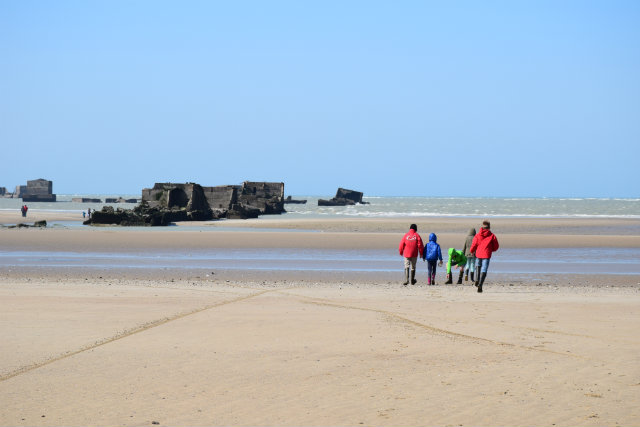
The Landing Beaches
You can visit over 30 historic sites in the region. Almosts these are the American cemetry at Omaha Beach, the Museaum of Arromanches, Pointe du Hoc, the Pegasus Bridge, St Mere Eglise, the Caen Mémorial, the British cemetry in Bayeux, and the German cemetry at Cambe. At Port en Bessin there is an ” Wrecks Museum “. This has resulted from 25 years of underwater exploration in the coastel landing area.
Each year, on June 6th, many villages commorate the landing of the allies on the D-Day. It is an emotional day in Normandy as allied forces remembered for their bravery in helping liberate France and subsequently the rest of occupied Europe.
June 6 Festivities Program
William The Conqueror
The story of William the Conqueror, as told by the famous Tapestry of Queen athilde, can be seen at Bayeux. The world renowned Tapestry is classified as a work of documentary heritage by UNESCO.
Each year, the first weekend of July, the city of Bayeux invites you to relive as in the time of the Dukes of Normandy thanks to medieval festivals.

Normandy and its Heritage
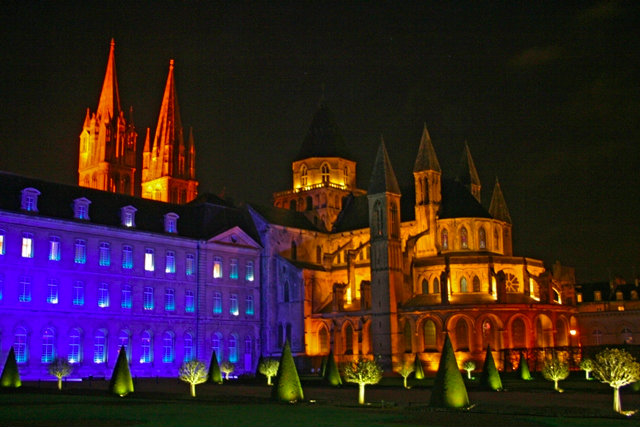
There is a rich architectural heritage to discover with many Norman castles, manors and farms built in stone from Caen. The Chateau de Creully, de Fontaine-Henry and of Balleroy, the Manoir d’Argouges, the Priory of St Gabriel Brécy and the Abbey de Juaye Mondaye are just a few of these. . A little further on, discover the cit of Caen. Here you can visit the feudal Chateau of William the Conqueror and the two medieval Abbeys!
To the south of the region lies the famous bay of Mont Saint-Michel with its Abbey perched high on the rocky prominence. The stunning gardens at Giverny, made famous by the impressionist Claude Monet, are situated within easy reach between Rouen and Paris! You will be charmed by the beautiful little town of Bayeux with its medieval houses, mansions and the magnificent cathedral.
Normandie Food and Drink
Calvados, a land to discover….
Visit the cider and calvados producing farms in the region. Speciality caramels “bon bons” made with salted butter are from nearby Isigny-sur-Mer. Try freshly famed oysters at Asnelles or a seafoof platter at one of the many restaurants along the coast.
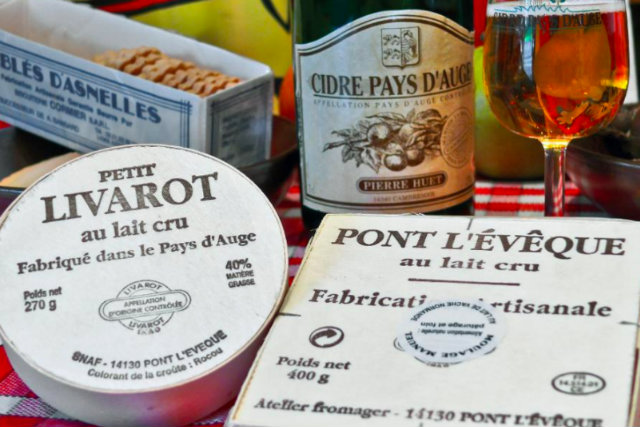
Leisures in Normandy
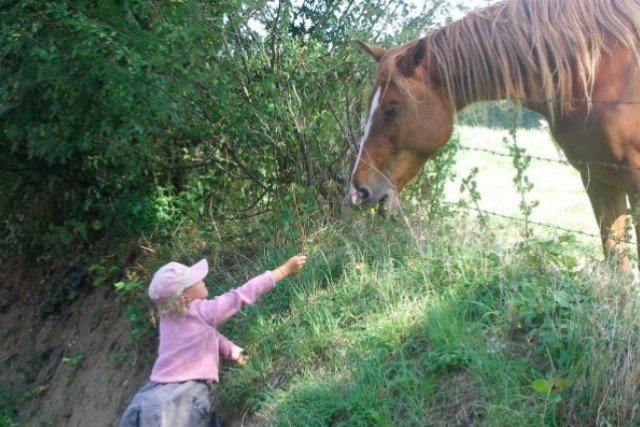
Sport & Nature
There are numerous trails for exploring the coast or the countryside by foot on bikes or on horseback.
Tours from the campsite, from the village of Martragny to walk, bike, ..
Many sporting activities are available in the area. There is an 18 hole golf course in Port-en-Bessin. The beach at Asnelles has sailing, kayaking and land yachting.
Every summer, next to Bayeux, there is a park with a maze and accrobranch course. Children and all ages are welcome. Site Bayeux Aventure
The Normandy beaches
Children will love playing on the many sandy beaches of this coastline. Splaching in the sea and building sandcastles, giving hours of fun !
Great sandy beach of Omaha Beach
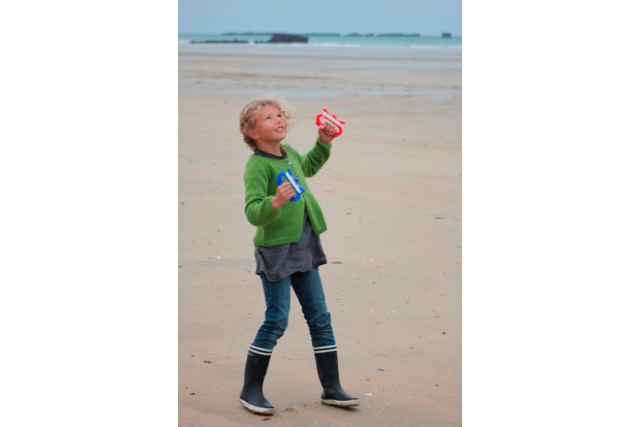
Parc & Zoo
- Zoo of Jurques
- Zoo of Cerza
- Festyland, amusement park in Breteville-sur-Odon (Caen)
- Indoor Pools with slide in Carpiquet (15km)
- Bowling in Bayeux (7km)
- Cité de La Mer in Cherbourg
Link for more informations (opening hours, entrance fee,…)
Yacht Charter in Normandy
Situated on the north-western coast of France, Normandy is a magnificent region rich in heritage and tourist activity. Its natural landscapes and numerous tourist attractions make Normandy a popular destination for globetrotters from all over the world. A yacht charter in Normandy is the perfect way to explore this region that opens onto the English Channel. With the famous ports of Le Havre and Cherbourg among many others, set off on an exceptional cruise on the French coast.
23 Boats to rent in Normandy
Sun fast 37 (2005).
Granville - Chausey (France) 3 Cabins • 6 Berths • 37 ft
From 1 500 €
Dufour 34 Performance (2006)
Granville - Chausey (France) 3 Cabins • 6 Berths • 35 ft
Bavaria C42 (2022)
Cherbourg (France) 3 Cabins • 6 Berths • 42 ft
From 2 350 €
Gib Sea 84 (1984)
Granville - Chausey (France) 2 Cabins • 4 Berths • 29 ft
First 31.7 (2001)
Granville - Chausey (France) 2 Cabins • 4 Berths • 32 ft
From 1 180 €
Ovni 345 DI (2000)
Granville - Chausey (France) 3 Cabins • 6 Berths • 36 ft
From 1 620 €
Oceanis 411 (2006)
Granville - Chausey (France) 4 Cabins • 8 Berths • 42 ft
From 1 740 €
Sun Odyssey 43 (2006)
Granville - Chausey (France) 4 Cabins • 8 Berths • 43 ft
From 1 920 €
Types of boats available for charter in Normandy
Sailboat charter normandy, rib charter normandy.
Prices on request
Don't miss it in Normandy
Yacht charter lower normandy, top 5 reasons to rent a yacht in normandy, 1. mont-saint-michel.
Visited by over three million people each year, Mont-Saint-Michel and its bay are both UNESCO World Heritage Sites. It was in this exceptional setting that monks decided to build an abbey at the end of the 10th century. Destroyed by the wars and rebuilt by the monks, the site was subject to the wrath of history and the evolution of religious architecture over the following centuries – yet never ceased to gain in beauty. Definitively completed at the end of the 19th century, this architectural masterpiece is well worth the 450 steps leading to its summit. And once at the top, you can enjoy the incredible panoramic views of the immense bay. Cast off from Granville and sail a few kilometers south to visit this world-class monument.
2. D-Day Landing Beaches
Whilst they do not form the most attractive coastline of Normandy, the beaches chosen for the Allied Forces landings in 1944 are among the most captivating sites in the Normandy region. Plunging visitors back into one of the most dramatic episodes in 20th century history, these sites of remembrance are sure to move all visitors. From the Côte de Nacre to the edge of Cotentin, every beach, site, memorial and cemetery tells a different human story.
3. Cliffs of Étretat
Proclaimed by many as the most beautiful natural coastal sites of Upper Normandy, the cliffs of Étretat have been immortalized by many famous painters down through the years. A series of chalk cliffs, including three natural arches and a rock formation called the Needle comprise the Étretat Chalk Complex. Aboard your chartered yacht in Normandy, what better way to see this stunning towering landscape! It’s the ideal place to capture some stunning Instagram-worthy pictures.
4. Spoilt for choice with seafood galore!
Bordering the English Channel means that this region has a plentiful supply of delicious and fresh seafood. Have your pick of clams, scallops, oysters or mussels aboard your boat charter in Normandy … your cook will only be delighted to prepare some local culinary dishes such as Marmite Dieppoise (a fish stew) or Coquille Saint Jacques (a scallop, shrimp and mussel-based dish).
5. Architecture that you won’t find anywhere else in France
Normandy’s ‘chaumières’ or thatched country cottages are rarely seen in other parts of metropolitan France. This medieval and Gothic-influenced architecture has a distinctive aesthetic and feel. You’ll notice a distinct contrast between the new and the old as much of these buildings were rebuilt following the Second World War. These dainty homes are charming, unique and full of character.
Getting There
From abroad, it’s best to fly into Paris (Charles de Gaulle or Orly airports) and then continue your onward journey to Normandy by train (daily departures from Paris). Caen-Carpiquet airport, located in the Normandy region, operates some regional flights to other European cities including London, UK. Several major airline companies operate direct flights from Paris to the USA and Canada. You can choose from a variety of marinas to begin your yacht charter in Normandy including Le Havre, Deauville, Saint-Vaast-la-Hougue, Cherbourg-Octeville, Granville and more.

Rangers led the way in the D-Day landings 80 years ago
Assistant Professor of History, University of Texas at Arlington
Disclosure statement
James Sandy receives funding from the U.S. Army Heritage and Education Center at Carlisle Barracks, PA.
University of Texas Arlington provides funding as a member of The Conversation US.
View all partners
Among the 150,000 soldiers who landed on and fought across the hostile beaches of Normandy on D-Day, June 6, 1944, were 1,000 members of a new, specially trained unit – the U.S. Army Rangers.
Most of them fought across the German beachfront defenses, supported by nearly 7,000 naval vessels and 11,000 Allied aircraft . More than 200 Rangers fought vertically – up the sheer cliff face of Pointe du Hoc, a craggy outcropping overlooking the two American landing beaches – in an effort to capture what was thought to be a key location of German artillery.
As a military historian of what I call the American Ranger tradition, I’ve traced this martial phenomenon from the colonial period to the 21st century. Their pathway to Normandy and their exploits that fateful morning represent a core component of the modern U.S. Army’s culture and evolution in the decades since.
Ranger rebirth
The idea for the U.S. Army Rangers was inspired by British Prime Minister Winston Churchill’s idea for what he called a “butcher and bolt” force – small teams that would conduct surprise attacks, kill or destroy key enemy targets, and escape undetected. The Commandos, as these British units were called, conducted high-profile and daring raids into occupied Europe from 1940 to the end of the war. Their sudden and shocking assaults along the French and Norwegian coastlines provided a boost in British morale during the dark early days of the war.
In spring 1942, Gen. George C. Marshall, the U.S. Army’s chief of staff, agreed to send a small detachment of Americans to train with the British commandos to gain combat experience. These American troops were then supposed to be sent to units across the United States’ rapidly growing army to share their expertise as new recruits prepared to go to war.
Gen. Lucian Truscott Jr., who had made the initial pitch to Marshall, believed the term “commando” was too British and instead argued that these men should be called “Rangers.” Truscott recalled the tenacity, flexibility and aggressive nature of colonial forces like Rogers’ Rangers , famous for daring raids during the French and Indian War in the 1750s and 1760s. Truscott believed that “ few words have a more glamorous connotation in American military history ” than the word “ranger.”
The 1st Ranger Battalion was trained by the British Commandos . A select few of them joined the British and Canadians in an August 1942 raid across the English Channel into Dieppe, France, which resulted in catastrophic losses and hard-learned lessons for the eventual landings at Normandy. Those Rangers were the first U.S. troops to fight in Europe during World War II.
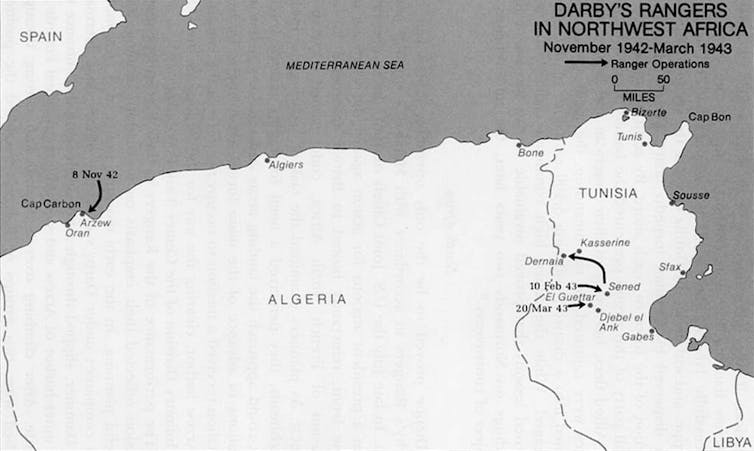
In November 1942, the 1st Ranger Battalion took part in Operation Torch , the Allied invasion of northern Africa. They captured the port town of Arzew, Algeria , without firing a shot during the invasion’s opening hours. They conducted daring nighttime raids, like the one on the Italian military outpost at the Sened Station in Tunisia, and were essential to Gen. George Patton’s breakout at Tunisia’s Djebel el Ank in 1943 .
The unit was so successful that the Army created additional Ranger battalions for the invasions of Italy and France, which were still being planned and would be undertaken in 1943 and 1944, respectively.
As these new battalions were forming and training, two in Africa and two in Tennessee , there was some confusion among Army commanders about how they would be used in combat. Were they specialized raiding forces like the commandos, or elite infantry meant to spearhead beach landings and other large-scale offensives? The 1st Rangers had done both in Africa, and these new Rangers would be asked to do so as well.
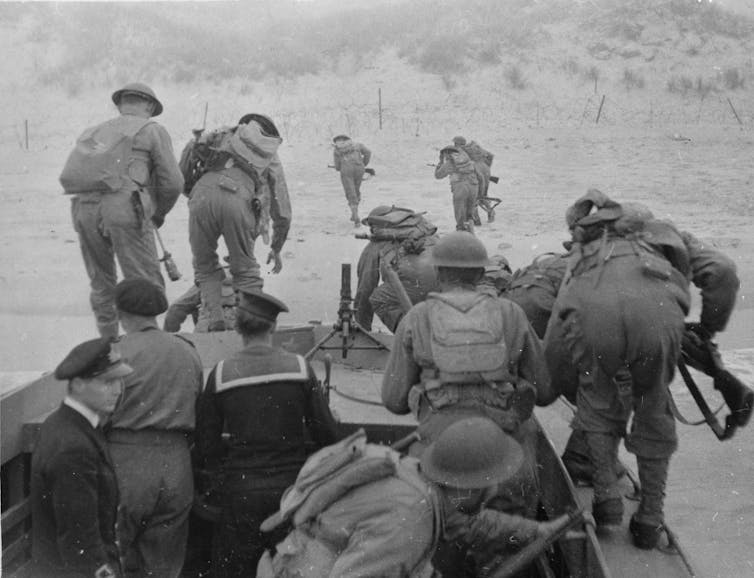
These new Ranger battalions were less heavily armed than their conventional counterparts. While they fit under the same organizational framework, they lacked the heavier weapons and internal artillery capabilities of a standard American infantry battalion.
As the Allied campaign pushed across northern Africa and into Italy, the Rangers found themselves consistently on the front lines of the Allied advance, where they suffered disastrous casualties fighting in prolonged conventional battles they were neither designed nor equipped for.
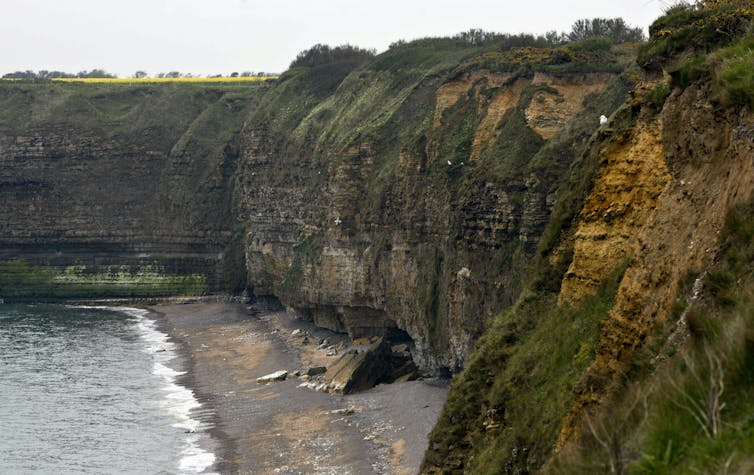
Rangers for D-Day
Like the rest of the D-Day force, the Rangers prepared for the operation without knowing when or where it would take place.
The newly organized 2nd and 5th Ranger battalions arrived in England in January 1944 and, alongside the more than 2 million other Allied soldiers on the British Isles, started preparing for the Normandy landings. The Rangers completed the murderous Commando training course in Scotland, famous for its grueling hill runs and use of live ammunition, spent weeks practicing amphibious landings along the English coastline, and scaled the towering seaside cliffs near Swanage more times than they could count .
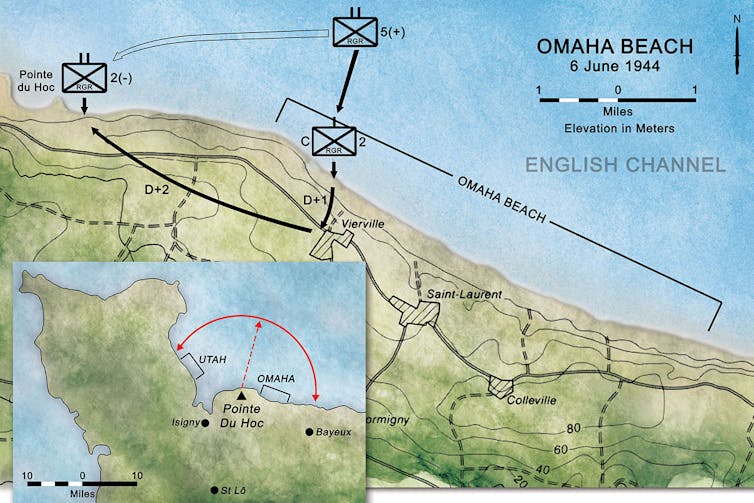
On the fateful morning of the Normandy landings, the Ranger battalions were split into three groups with two distinct assignments .
Task Force A, three companies led by Lt. Col. James Rudder, was assigned the most difficult mission: Pointe du Hoc. Using rocket-propelled grappling guns, rope and specialty fire ladders, the Rangers needed to climb 90 feet of sheer rock face under German fire, take the cliff top and destroy a group of 155 mm German guns overlooking the landing beaches.
Task Forces B and C, the remaining Rangers, were insurance. Depending on what happened at the cliffs, these Rangers had to land and fight across Omaha Beach and either rescue a faltering cliff assault or support the 29th Infantry Division in clearing the beach and taking the critical town of Vierville.

The fight at Pointe du Hoc
Rudder’s Task Force A had a rough start: A wrong turn in their landing craft put them 30 minutes behind schedule. The 225 Rangers finally started their climb well after sunrise and were met with intense German fire from above. Many of the first men to reach the top only did so with their hands and knives – their ropes had been cut.
But 30 minutes after they started climbing, the Rangers had reached the craggy and blasted top of Pointe du Hoc. Numbering barely 70, they found no functional German guns, which had either been destroyed in pre-invasion bombardments or moved by the Germans just days before.
Landing on Omaha Beach
By the time the 800-plus Rangers of Task Forces B and C landed on Omaha Beach, they had not yet heard from the delayed cliff assault team amid the chaos of the morning’s fight.
Within minutes, concentrated German machine gun fire devastated the men struggling up the beach. Nearly half of Lt. Col. Max Schneider’s force were killed or wounded as they made their way onto the beach. The rest hid behind a low seawall. Brig. Gen. Norman Cota approached the gathered troops. After a short and heated discussion with Schneider, the Rangers heard Cota yell something about needing to get troops off the exposed beach.
His order became the current 75th Ranger Regiment’s motto: “ Rangers, Lead the Way !” Using explosives specially designed for clearing obstacles , the Rangers cleared a pathway through the German barbed wire, and the assault up the beach began anew.
Famously reenacted by Tom Hanks and his fellow on-screen Rangers in 1998’s World War II epic “Saving Private Ryan,” the Ranger attack kick-started one of the first major breakthroughs of the morning. Before long, American soldiers were face to face with German defenders and opening large gaps in the defenses on their way to taking the beach and pushing inland.
A few among many
Like most of the troops on D-Day, the men of the 2nd and 5th Rangers experienced combat for the first time on those beaches and cliffsides. They paid a heavy price for the Allied victory: Nearly 400 of the original 1,000 Rangers who set out for Normandy were killed, wounded or missing. Overall, 4,000-plus Allied soldiers were killed on the day of the invasion, with 5,000 more wounded.
The Rangers were a small part of the overall operation, but they epitomize the strength, adaptability and determination of every service member who stepped foot on those beaches, piloted those landing craft, flew air support or toiled on an off-shore warship.
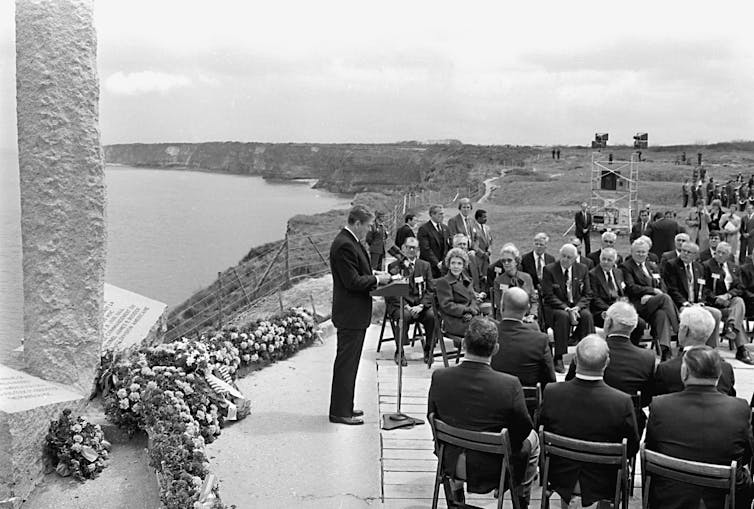
Four decades after D-Day, U.S. President Ronald Reagan visited Pointe du Hoc and paid his respects to the 62 surviving members of the 2nd Rangers who had climbed the cliffs. He honored them – and every other young man who stormed the beaches of Normandy :
“These are the boys of Pointe du Hoc. These are the men who took the cliffs. These are the champions who helped free a continent. These are the heroes who helped end a war.”
- World War II
- Winston Churchill
- Ronald Reagan
- Omaha Beach
- Normandy invasion

Head, School of Psychology

Senior Lecturer (ED) Ballarat

Senior Research Fellow - Women's Health Services

Lecturer / Senior Lecturer - Marketing

Assistant Editor - 1 year cadetship
Watch CBS News
CBS News Texas to return to Normandy with North Texas D-Day heroes
Trudeau to travel to France for 80th anniversary of D-day at Juno Beach
Trudeau also attended 75th anniversary of d-day in france in 2019.

Social Sharing
Prime Minister Justin Trudeau will travel to France next month for the 80th anniversary of D-Day.
Trudeau will spend two days in France to attend D-Day events including a Canadian ceremony at Juno Beach on the morning of June 6, marking exactly 80 years since 14,000 Canadians stormed the beach as part of a massive Allied forces operation.
An international ceremony will be held later the same day on Omaha Beach.
On June 5, a memorial will take place at the Beny-sur-Mer Canadian war cemetery where 2,049 Canadian soldiers are buried.
D-Day is considered to be the beginning of the end of the Second World War, ultimately leading to the Allies liberating Western Europe from the Nazis less than a year later.

Canadians hold massive D-Day event at Juno Beach
But it came at a heavy cost, with 381 Canadians killed on the first day of the invasion and more than 5,000 by the time the Battle of Normandy concluded three months later.
Trudeau is expected to use the ceremonies to highlight that the aftermath of the Second World War "led to the foundation of the modern rules-based international order" which Canada soundly defends.
He has used many speeches in recent months to talk about growing threats to that rules-based order around the world.
Canada has not yet commented on the fact that French President Emmanuel Macron invited Russian officials to attend some of the official D-Day events despite Russia's ongoing invasion of Ukraine.
- D-Day anniversary commemorated on bus shelters
- Analysis D-Day at 75: Why the beginning of the end of WWII resonates today
Russian President Vladimir Putin, for whom the International Criminal Court has issued an arrest warrant for war crimes, was not invited.
Trudeau has repeatedly said Russia's unprovoked attack on Ukraine is a threat to peace and stability around the world.
The organizer of the D-Day commemorations in France, known as Mission Liberation, said in a statement in April that France had always invited countries whose troops landed in Normandy, including the Russian Federation.
Putin did receive an invitation and attend ceremonies to mark the 60th and 70th anniversaries of D-Day, the latter of which took place just a few months after Russia annexed the Crimean Peninsula in Ukraine.
Trudeau attended ceremonies in France to mark the 75th anniversary of D-Day in 2019.
- 0 Favorites
Catch the ferry to Normandy!
Normandy Tourism, France
- Active & outdoor
- Lifestyle & Wellness
- Discover Normandy
- Plan your trip

Plage de Dieppe © B. Collier
Find out more
Updated on 8 January 2024
Reading time: 4 minutes
Add to my bookmarks :
- Add to bookmark
Now that ferries are making a comeback and that many tourists are staying away from flying, Normandy is back on the map as a greener and easily-accessible holiday destination. With five different routes from England and two from Ireland to choose from, you’re sure to find one that suits your needs and tastes!
ferries are back in style!
These days, as people become more aware of their carbon footprint and the international health crisis is changing our travel habits, the ferry is seeing a real resurgence in popularity. Seen as a cleaner alternative to flying, ferry travel is also considered less stressful. Airport delays, increased security and luggage restrictions have had passengers tearing their hair out, and the recent Covid-19 measures haven’t made things easier. When catching the ferry, you can travel in the comfort of your own car and enjoy lots of space and fresh air once on board! If you’re a cycling enthusiast, you can take your bike too. Dogs are also accepted on several lines. Our beautiful part of France boasts four ferry ports linking us to Portsmouth, Poole and Newhaven in the UK, and to Dublin and Rosslare in Ireland. Take a closer look at the different options you have:
From the United-Kingdom:
Portsmouth to caen-ouistreham.
- Service operated by Brittany Ferries
- Crossing time: approximately 6 hours (option of 9h overnight travel)
- 3 sailings a day in each direction
- Crossings are carried out by two ferries: MV Mont St Michel and MV Normandie
- Crossing capacity: 2 100 passengers
- Cabins available for overnight sailings
- Ferry port located just 10 miles from Caen city centre
newhaven to dieppe
- Service operated by DFDS
- Crossing time: approximately 4 hours
- Up to 4 crossings a day in each direction
- Crossings are carried out by two sister ships: MS Seven Sisters and MS Côte d’Albâtre
- Crossing capacity: 600 passengers
- Ferry port is located one mile from Dieppe town centre. Dieppe is the closest port and beach to Paris.
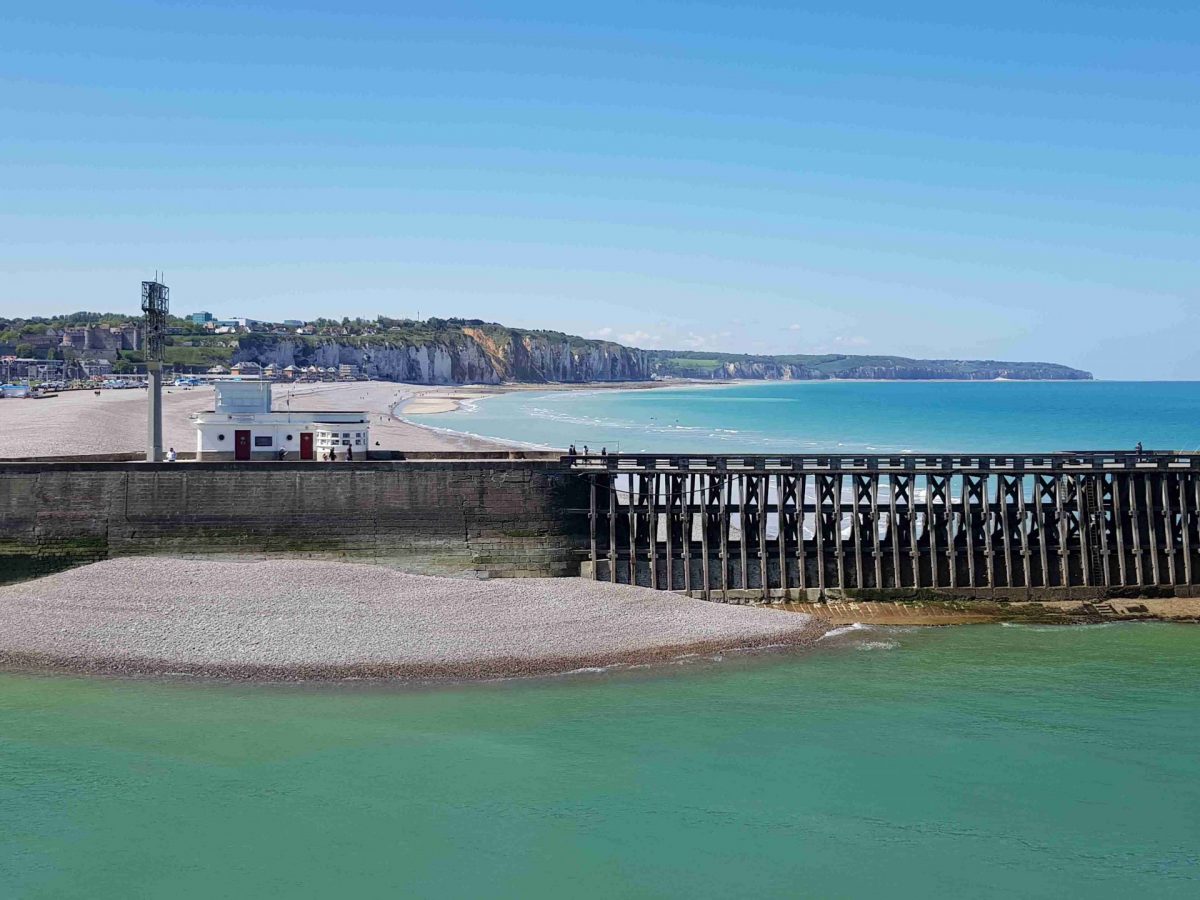
PORTSMOUTH TO CHERBOURG
- Twice weekly overnight sailings on the brand-new cruise ferries, Galicia, Salamanca and Santoña
- Crossing time: approximately 5-8 hours
- 2 sailings a week in each direction
- Crossing capacity: 1 100 passengers
- Ferry port located two miles from Cherbourg city centre
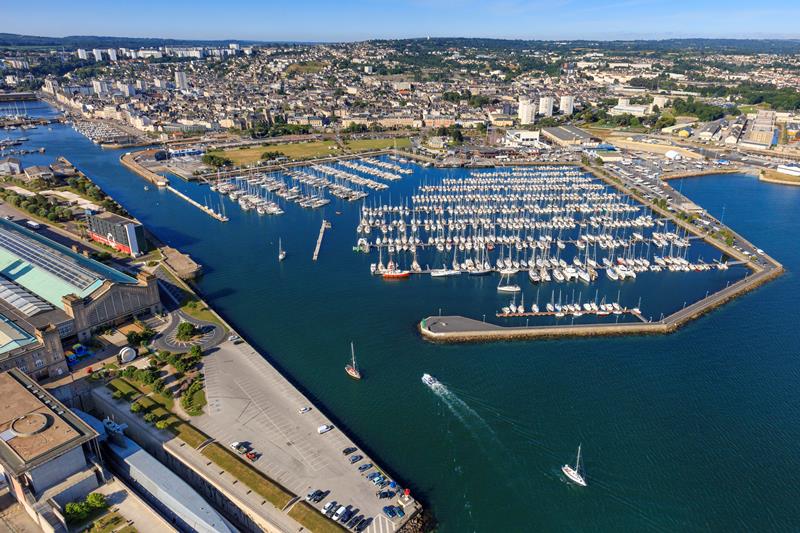
POOLE TO CHERBOURG
- Seasonal service (March – November) operated by Brittany Ferries
- Crossing time: approximately 4 hours and 30 minutes
- 1 sailing a day in each direction
- Crossings are carried out by the MV Barfleur
- Crossing capacity: 1 200 passengers
Portsmouth to le havre
- Crossing time: approximately 5 hours and 30 minutes (option of 9 hrs 45 mins overnight travel)
- 1 sailing a day in each direction (4 days a week)
- Crossings are carried out by the MV Cotentin
- Crossing capacity: 200 passengers
- Ferry port located one mile from Le Havre city centre. This is Brittany Ferries’ closest crossing to Paris, just 2 hours drive from Le Havre.
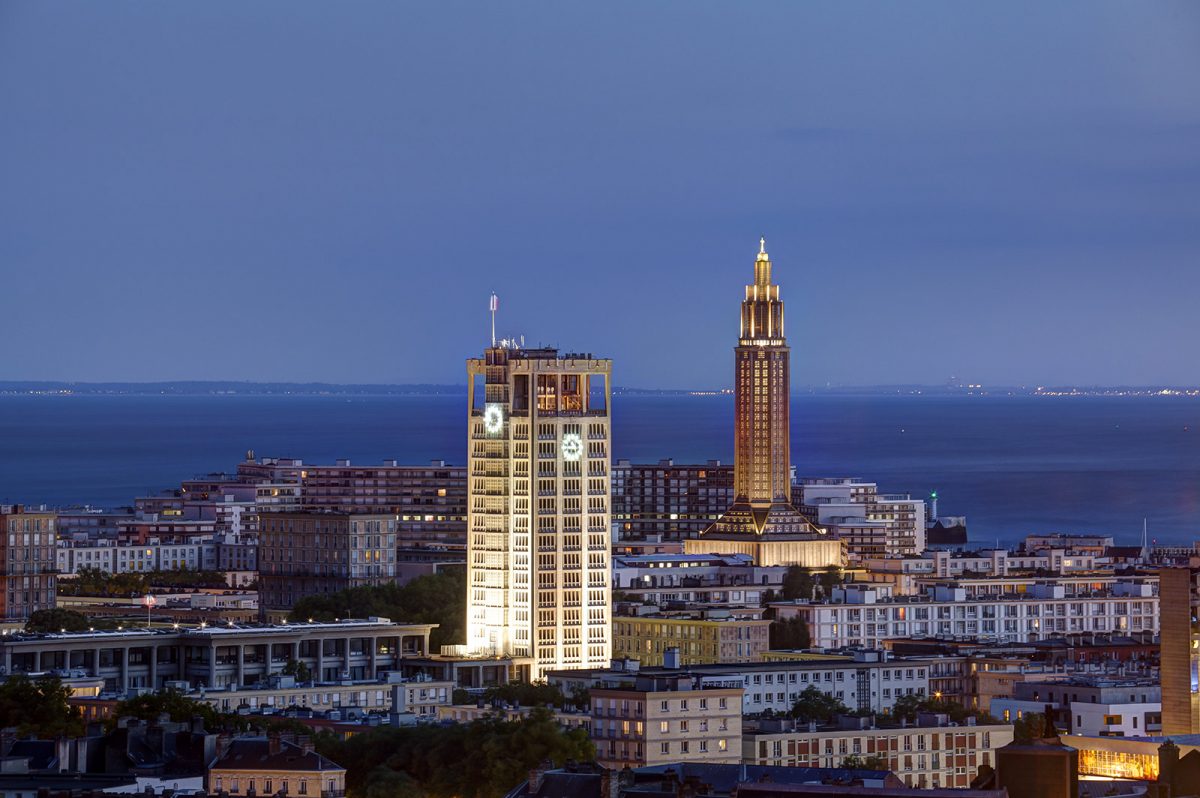
HIGH-SPEED PORTSMOUTH – CHERBOURG – POOLE SERVICE
- Seasonal high-speed service operated by Brittany Ferries
- Fastcraft will operate Friday – Sunday from 24 May to 2 June, and from 12 July to 1 September 2024
- Crossing time: approximately 3 hours
- Crossings are carried out by the Liberation fastcraft ferry
- Crossing capacity: 850 passengers
FROM IRELAND:
Dublin to cherbourg.
- Service operated by Irish Ferries
- Crossing time: approximately 17 hours (overnight travel)
- 3 crossings a week in each direction
- Crossings are carried out by the W.B. Yeats
- Crossing capacity: 1885 passengers
- 435 individual cabins available for all sailings
- Ferry port is located two miles from Cherbourg city centre
Rosslare to Cherbourg
- Crossing time: approximately 19 hours (overnight travel)
- 3 sailings a week in each direction
- Crossings are carried out by MV Galicia, MV Salamanca, MV Santoña and MV Cotentin
- Crossing capacity: from 200 to 1100 passengers depending on the ferry
- Cabins available for all sailings
ROSSLARE TO CHERBOURG
- Service operated by Stena Line
- Crossing time: approximately 18 hours (overnight travel)
- 3 to 6 crossings a week in each direction
- Crossings are carried out by the Stena Vision and the Stena Horizon ferries
- Crossing capacity: from 660 to 1300 passengers
FROM THE CHANNEL ISLANDS:
- Manche Iles Express *: From Diélette, Barneville Carteret and Granville, to the Channel Islands of Jersey, Guernsey, Sark and Alderney, and to the Chausey Islands
- Condor Ferries* : From Cherbourg to Guernesey
- Jolie France *: From Granville to the Chausey Islands
*Please note some ferry crossings are seasonal

DUTY FREE IS BACK!
Duty free has now returned on ferry routes between the UK and France for the first time in more than 20 years. The end of the Brexit transition period saw duty free shopping make a comeback on 1 January 2021. Passengers are now able to load their luggage with tax-free tobacco, alcohol and perfumes again. Yet another reason to hop on the ferry and visit Normandy!

Dieppe market, France’s finest
Updated on 13 November 2023
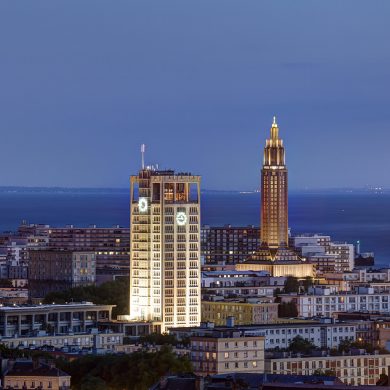
24 hours in Le Havre: Cool and alternative things to see and do
Updated on 21 December 2022

The Rolex Fastnet Race returns to Cherbourg
Don’t miss.
How to get to Normandy? Unmissable Caen Unmissable Cherbourg Unmissable Dieppe Unmissable Le Havre
Return to top
Are you already in Normandy?
Plan what to see and do while you’re here by visiting normandy-secrets.com, which lets you in on all of the local secrets and hidden gems in the immediate vicinity!
Close search box
- Vote In Our Poll
- Photo Galleries
- Election 2024
- This Week in the 904
- Action Button Links
- Newsletter Sign-up (Opens in new window)
- Clark Howard
- Watch Live: Action News Jax NOW
- Action Sports Jax 24/7
- Action News Jax 24/7 News
- Weather 24/7 Stream
- Social Media
- What's on CBS47 & FOX30
- The $pend $mart Stream
- Law & Crime
- Curiosity NOW
- Eclipse 2024
- Dog Walk Forecast
- First Alert Neighborhood Weather Stations
- Hurricane Center
- Talking the Tropics
- First Alert Doppler HD
- Interactive Radar
- First Alert Wx App (Opens in new window)
- Hour by Hour
- 7-Day Forecast
- Weekend Forecast
- Buresh Blog
- Sunrise & Sunset Shots
- Share Your Pics!
- Priced Out Of Jax
- Restaurant Report
- Jacksonville Jaguars
- College Sports
- THE PLAYERS Championship
- Friday Night Blitz
- Tenikka's Books for Kids
- Community Calendar
- Steals and Deals
- Gas Prices (Opens in new window)
- FlightAware (Opens in new window)
- Telemundo Jacksonville
- Action News Jax Team
- MeTV on MyTVJax (Opens in new window)
- Jobs at Cox Media Group (Opens in new window)
- Submit Events
- Visitor Agreement
- Privacy Policy
- Local Solutions (Opens in new window)
- Jax Home Experts
- Around Town
Action News Jax Now
JSO: Man dead after shooting in parking lot of Normandy liquor store, hookah lounge
JACKSONVILLE, Fla. — Jacksonville Sheriff’s Office is investigating after a man was shot in the parking lot of Charlie’s Liquor in Normandy.
>>> STREAM ACTION NEWS JAX LIVE <<<
Detectives said that at around 1:10 a.m. on Monday, a man was dropped off at a local hospital with a gunshot wound and later died. Police were able to locate the shooting location in the parking lot of Charlie’s Liquor, which is connected to a hookah lounge.
Police believe that multiple shots were fired in the parking lot during an argument between the victim and the suspect, who left the scene. Witnesses said he was a man wearing all black.
Read: One killed in officer-involved shooting after driving dispute in Brentwood area
There were also over 100 people or more at the hookah lounge when the shooting happened.
Detectives are currently interviewing the witness who drove the victim to the hospital.
Anyone with information about this incident is asked to call JSO at 904-630-0500 or Crime Stoppers at 866-845-TIPS.
Action News Jax will continue to follow the story and will update you as we learn more.
Read: Fire scorches 6 units of apartment complex in Jacksonville’s Westside over Memorial Day Weekend
[SIGN UP: Action News Jax Daily Headlines Newsletter ]
Click here to download the free Action News Jax news and weather apps, click here to download the Action News Jax Now app for your smart TV and click here to stream Action News Jax live.
:quality(70)/cloudfront-us-east-1.images.arcpublishing.com/cmg/K3I77JT3SMOOZIRFXGTQ26MVXI.jpg)
Man dies while standing in parking lot when car overturns off road in Nassau County
:quality(70)/cloudfront-us-east-1.images.arcpublishing.com/cmg/OBXHMBUS6ZSRNQJXJYXSH6TWXY.jpg)
North Korean rocket carrying its 2nd spy satellite explodes shortly after launch
:quality(70)/d1hfln2sfez66z.cloudfront.net/05-27-2024/t_0be71bf61ede43d7805ce719f2588c61_name_file_960x540_1200_v3_1_.jpg)
Former Jacksonville Jaguars kicker accused of sexual assault in newly filed civil suit
:quality(70)/cloudfront-us-east-1.images.arcpublishing.com/cmg/A6EPZEHBUBG73L5Q4HPQ3KXU4A.jpg)
2 people rescued after 80-foot yacht sinks off coast of St. Augustine Beach
:quality(70)/cloudfront-us-east-1.images.arcpublishing.com/cmg/FF5LMSVVU5HWTI2B26PDIPB2LE.jpeg)
Georgia Sen. Warnock grounds state legislatures’ attempts to seize control of Atlanta Airport

COMMENTS
Sand yachting on the long sandy beaches in Normandy makes for fun memories! For a fun photo option, check out our selection of spots: in the Manche, in the seaside resorts of Cabourg, Deauville, Trouville-sur-Mer, on the D-Day Landing Beaches. Types.
Watch me as I take the drone up to new heights in Normandy once again! If you liked this video, please leave a like and subscribe!SUBSCRIBE TODAY! http://bi...
4. Trouville-sur-Mer. To practice sand yachting in Normandy in a mythical place, you have to come to Trouville-sur-Mer. Located very close to Deauville, this seaside resort is the oldest in the region. Its large sandy beach stretches for 1.2 kilometers. It combines nautical leisure, relaxation and history.
An incredible adrenaline rush, land sailing, (though requiring minimum wind speeds of 10mph), offers you the chance to reach up to 3 or 4 times the wind speed of the area you're doing it in! It's also a great year-round sport, with the best times of the year to practice it being between March - November in America and Europe due to the ...
Course of events. - Meeting point at EOLIA Normandy Omaha Beach - Lieu dit, 14710 Colleville-sur-Mer. - Briefing on the activity, equipment and safety rules. - Set up of the equipment and discovery of the sand yachts. - Sailing session on evolving courses.
Located amidst a magnificent panorama of nature and sea spray, Eolia Normandy offers you land yachting lessons by the magnificent heritage site of Omaha Beach. And to reward you for your efforts, enjoy a bite to eat at the fireside in the base's panoramic club house. For further information, consult our website at www.eolia-normandie.com.
The bay of Mont-Saint-Michel is an emblematic place, listed as a UNESCO World Heritage Site! It is along this bay that you will find the beach of Hirel, between Saint-Malo and the Mont-Saint-Michel. This large stretch of sand is a perfect place to practice sand yachting in Brittany. Our partner Avel Char à Voile welcomes you on the Hirel beach ...
The Land Sailing World Championship planned in Asnelles in 2024 is an event that highlights the importance and attractiveness of yachting as a sports discipline, but also its ability to bring together people from diverse backgrounds around a common passion for speed and technical mastery. ... It is a place where the natural beauty of Normandy ...
Land sailing, also known as sand yachting, land yachting or dirtboating, [1] entails overland travel with a sail -powered vehicle, similar to sailing on water. [2] Originally, a form of transportation or recreation, it has evolved primarily into a racing sport since the 1950s. Vehicles used in sailing are known as sail wagons, sand yachts, or ...
There were people playing on the beach, lots of land sailing going on and just a generally nice atmosphere. The town of Ouistreham is a pleasant town to spend a night as well with lots to see if you're interested in the landings. ... 2 thoughts on "Visiting the beaches of Normandy: D-Day landings and WW2 sites - your ultimate guide" ...
Visit the D-Day landing beaches in Normandy : Map + tips The 5 landing beaches - map and introduction. Operation Overlord, a.k.a. the Normandy invasion, began on June 6, 1944. 5 main areas were strategically chosen by the Allies on the Normandy coast. They cover a section of more than 80km (50 miles). Code names have been given:
Mont Saint Michel : Private Tour from Le Havre. 9. Ideal for cruise ship passengers, this full-day, private shore excursion in Normandy takes travelers to the stunning island of Mont-Saint-Michel and its centuries-old hilltop abbey.
11 Figures and information compiled from Atkinson, The Guns at Last Light, 15, 36-37; Murray and Millett, A War to be Won, 420; Craig L. Symonds, Neptune: Allied Invasion of Europe and the D-Day Landings (New York: Oxford University Press, 2014), 225-226, 305; and Ken Ford and Steven J. Zaloga, Overlord: The D-Day Landings (New York: Osprey ...
There are numerous trails for exploring the coast or the countryside by foot on bikes or on horseback. Tours from the campsite, from the village of Martragny to walk, bike, .. Many sporting activities are available in the area. There is an 18 hole golf course in Port-en-Bessin. The beach at Asnelles has sailing, kayaking and land yachting.
Testing out the land yacht for Normandy American heroes guests! #Omaha #WWII #wwiihistory #normandy #guidedtours #privatetour #historyfacts #DDay #DDay80. Rudy Passera · Original audio
TOP 5 REASONS TO RENT A YACHT IN NORMANDY. 1. Mont-Saint-Michel. Visited by over three million people each year, Mont-Saint-Michel and its bay are both UNESCO World Heritage Sites. It was in this exceptional setting that monks decided to build an abbey at the end of the 10th century.
Welcome to Normandy !!! We are a team of Normandy private tour guides giving guided tours to the d-day landing beaches (Omaha beach, Pointe du Hoc, American cemetery,…) and to the main sites of Normandy (Giverny, Mont Saint Michel, Bayeux, …). We are all licensed and are registered self-employed.
Among the 150,000 soldiers who landed on and fought across the hostile beaches of Normandy on D-Day, June 6, 1944, were 1,000 members of a new, specially trained unit - the U.S. Army Rangers.
Normandy is blessed with 600km of coastline, sun-kissed seascapes, lakes, rivers and waterways, making it one of the best regions in France to spend time in and on the water. Our region's an aquatic playground that seems purpose-built for watersports lovers! Our three coastal départements of Manche, Calvados and Seine-Maritime boast world ...
On 6 June 1944, more than 150,000 Allied troops landed on the beaches of Normandy in northern France for the start of Operation Overlord, now known as D-Day.
Next week marks the 80th anniversary of the D-day landings in Normandy, France. A moment in history that led to the downfall of Hitler. ... When CBS News Texas traveled to Normandy in 2013 and ...
The prime minister will visit Normandy, France in June to mark the 80th anniversary of the D-Day landings. Trudeau also attended 75th anniversary of D-Day in France in 2019
1 sailing a day in each direction; Crossings are carried out by the MV Barfleur; Crossing capacity: 1 200 passengers ... Yet another reason to hop on the ferry and visit Normandy! Dieppe market, France's finest. Updated on 13 November 2023 . 24 hours in Le Havre: Cool and alternative things to see and do. Updated on 21 December 2022 . The ...
JSO is investigating after a man was shot in the parking lot of Charlie's Liquor in Normandy. ... 2 people rescued after 80-foot yacht sinks off coast of St. Augustine Beach.